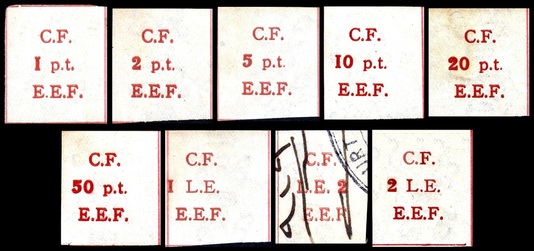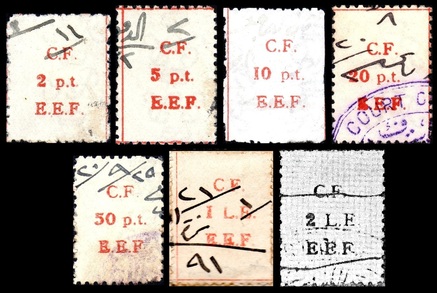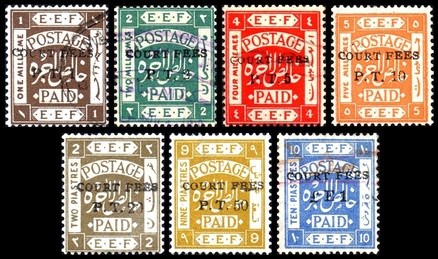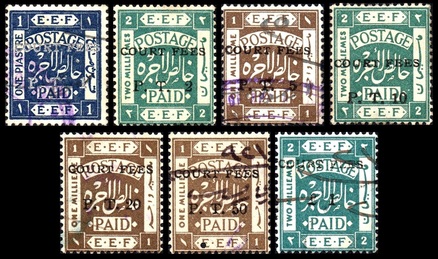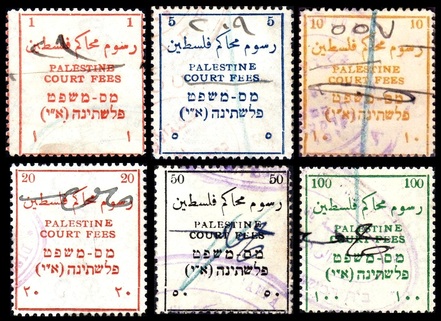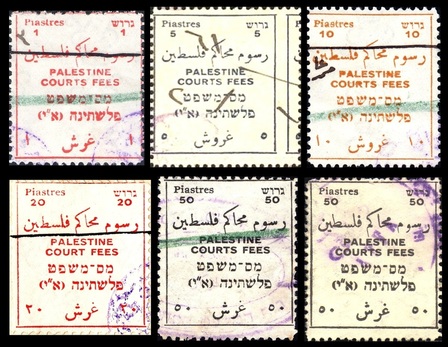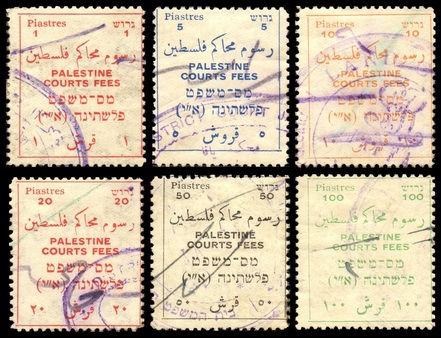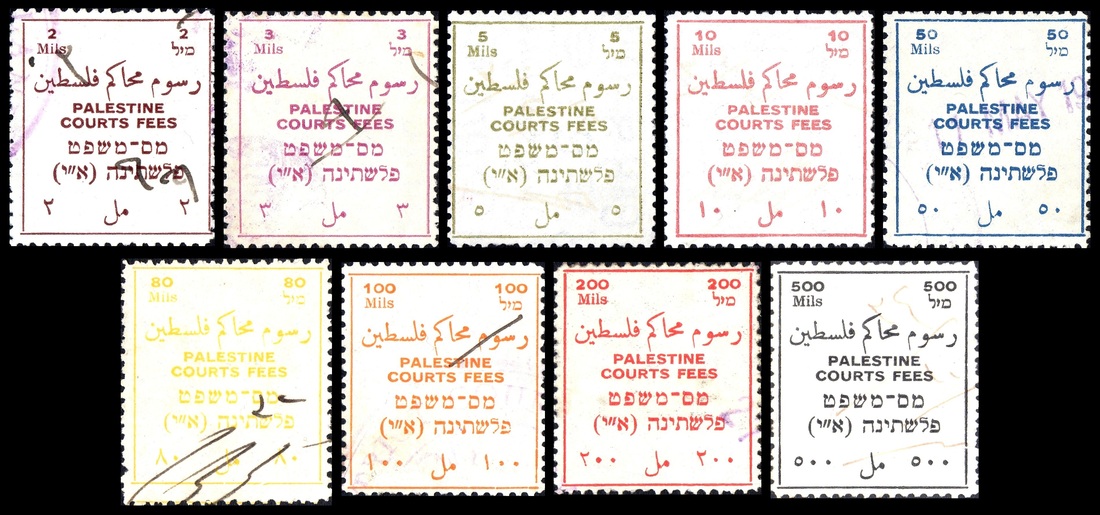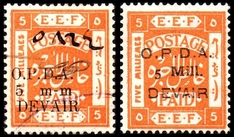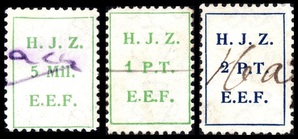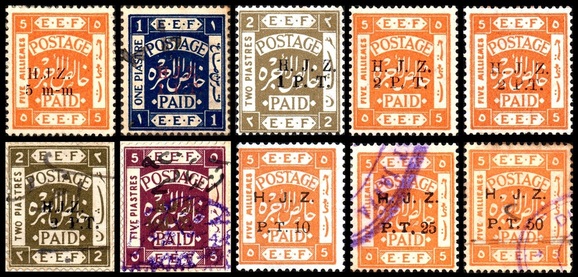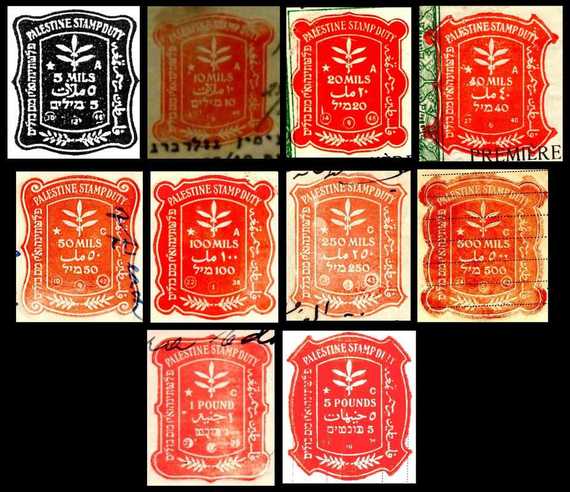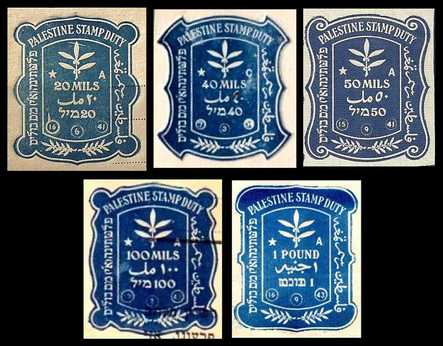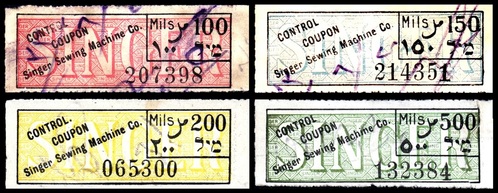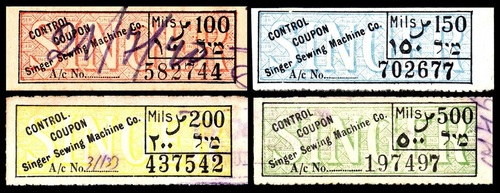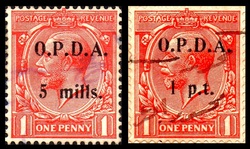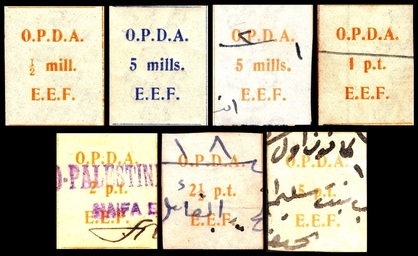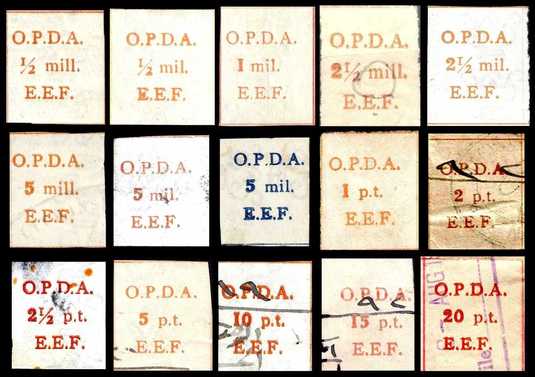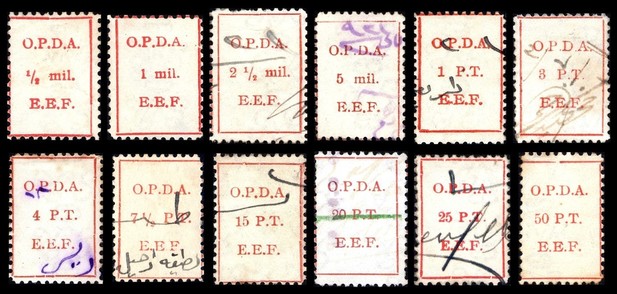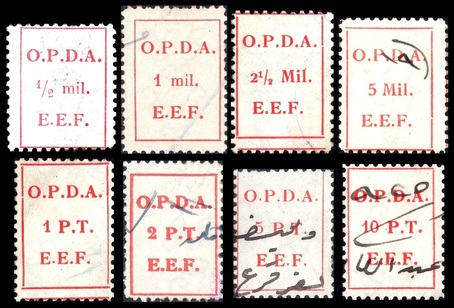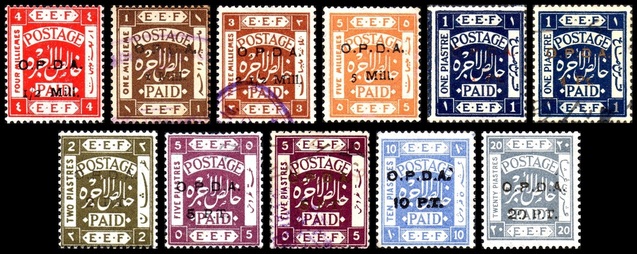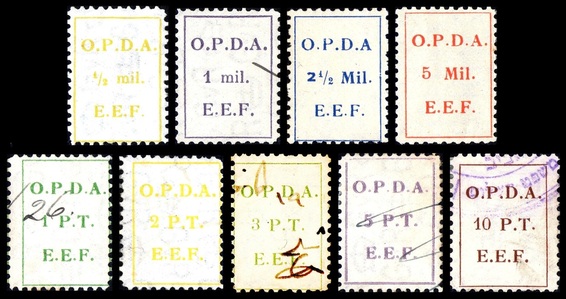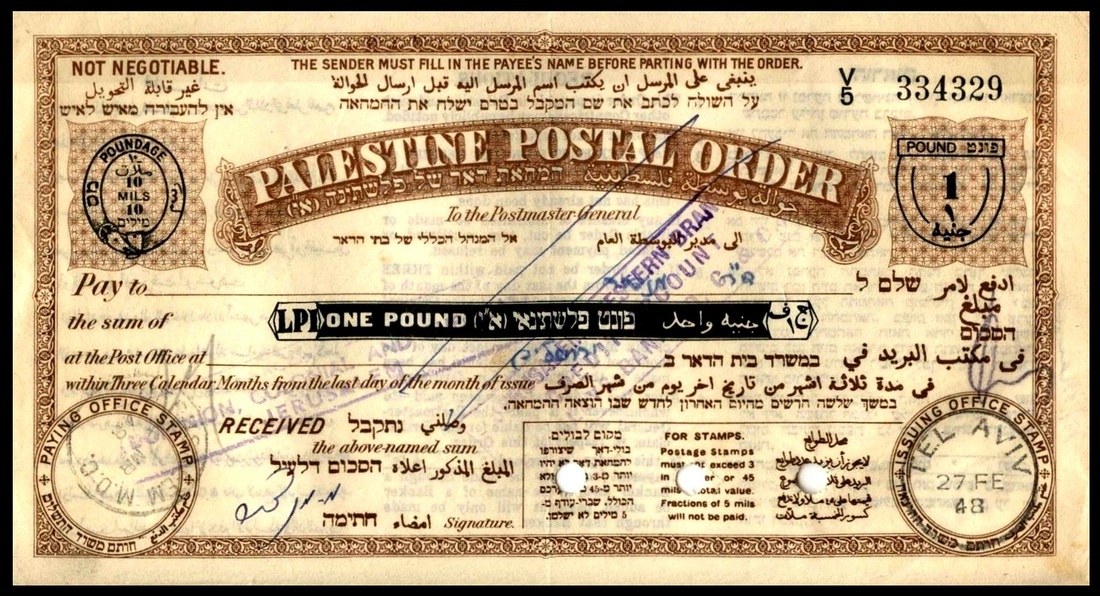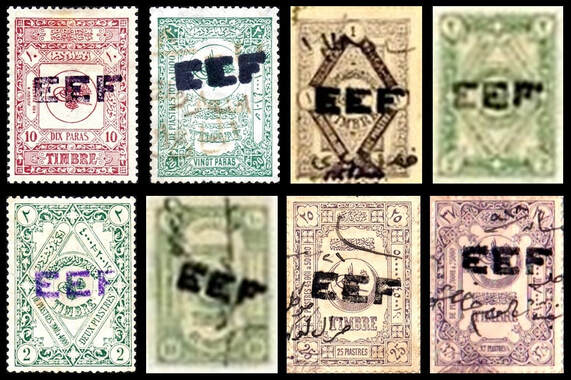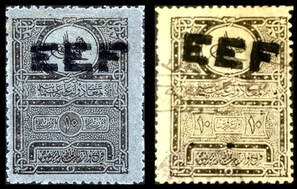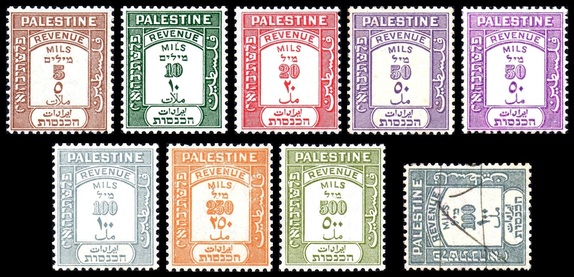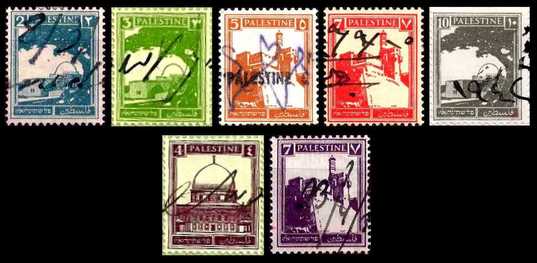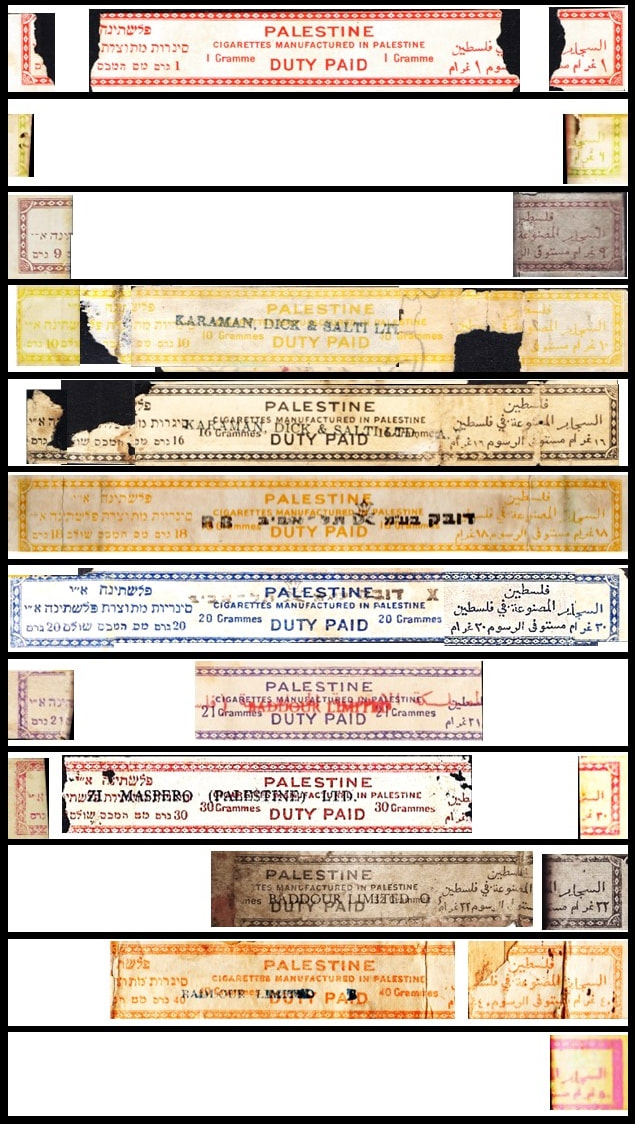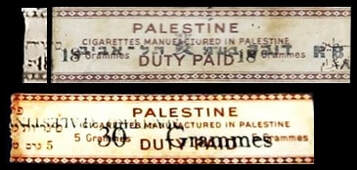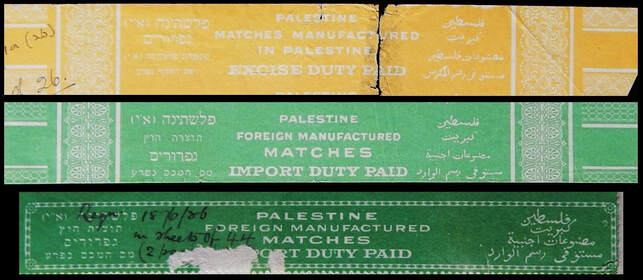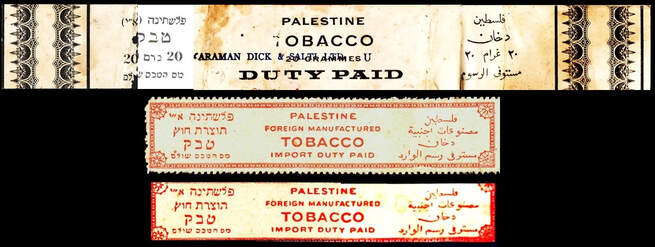Palestine
Chapter overview
Turkish revenue stamps overprinted EEF are listed on this page under Revenue. Similar issues but overprinted JM are listed under Jerusalem Municipality. Issues for the Singer Sewing Machine Company are listed under Labels.
Details of Palestine revenue printings, extracted from the Crown Agents Requisition books, can be found on a dedicated page here.
Currency
Acknowledgments
A cross-reference table relating my listing to the Bale, Wallerstein and Barefoot catalogues can be found on a supplementary information page here.
Grateful thanks to Wolfgang Morscheck of Bad Säckingen and to Taddeo Papi for providing a number of scans for this chapter.
- Identification guide for the small typeset issues
- Court Fee (catalogue numbers prefixed C)
- Devair Resmi (catalogue numbers prefixed D)
- Hejaz Railway (catalogue numbers prefixed H)
- Immigration and Consular Fee (catalogue numbers prefixed I)
- Impressed revenue stamps (catalogue numbers prefixed Z)
- Jerusalem Municipality (catalogue numbers prefixed M)
- Labels (catalogue numbers prefixed L)
- Ottoman Public Debt Administration (catalogue numbers prefixed O)
- Postal Order poundage (catalogue numbers prefixed P)
- Revenue (catalogue numbers prefixed R)
- Revenue usage of Postage stamps (catalogue numbers prefixed S)
- Tobacco and other Excise Banderolles (catalogue numbers prefixed X)
- Cigarettes (catalogue numbers X1/22)
- Cigars (catalogue numbers X31/38)
- Heisheh (catalogue number X41)
- Matches (catalogue numbers X51/53)
- Playing Cards (catalogue number X61)
- Snuff (catalogue numbers X71/72)
- Tobacco (catalogue numbers X81/87)
- Tombac (catalogue numbers X91/94)
Turkish revenue stamps overprinted EEF are listed on this page under Revenue. Similar issues but overprinted JM are listed under Jerusalem Municipality. Issues for the Singer Sewing Machine Company are listed under Labels.
Details of Palestine revenue printings, extracted from the Crown Agents Requisition books, can be found on a dedicated page here.
Currency
- 1000 mils = 100 piastres = 1 Egyptian (later Palestinian) pound
Acknowledgments
- Michael H Bale, The Stamps of Palestine Mandate: Specialized Catalogue, Revised and enlarged fifth edition (privately published, 1984)
- W Barber, The Impressed Duty Stamps of the British Colonial Empire (update to 1st Edition, privately published, Chesapeake, Virginia, 2009)
- J Barefoot Ltd, British Commonwealth Revenues (9th Edition, privately published, 2012)
- William Wallerstein, Palestine-Israel Revenue Catalogue (Mosden Trading Corporation, 1987)
- Michael Engel, Cigarette Pack Collector (retrieved 30 January 2023), www.cigarettepackcollector.com
A cross-reference table relating my listing to the Bale, Wallerstein and Barefoot catalogues can be found on a supplementary information page here.
Grateful thanks to Wolfgang Morscheck of Bad Säckingen and to Taddeo Papi for providing a number of scans for this chapter.
Identification guide for the small typeset issues
The identification of the small typeset revenue stamps of Palestine has troubled collectors, researchers and catalogue editors for many years. My attempt at bringing clarity and simplicity to a complex field is the latest in a long series, and I gratefully acknowledge my debt to those who have trodden the path before me.
My rule of thumb has been to focus on the features which distinguish one printing from another, and largely to turn a blind eye to variations within a given printing, even where this means blurring distinctions made by other writers. On this basis I have classified differences of shade, perforation and watermark orientation as being of only secondary importance, and have therefore consigned them to footnotes rather than main set headings.
The result is a division into four basic types - here labelled A to D - which differ in the style of lettering and the use of capitals or lower case to denote face values. Type B subdivides, with an imperforate and a perforated issue; type D subdivides by watermark, with initial printings on Script Cypher paper and a later reprint (involving a change of colour) on Block Cypher.
All four types were used for HJZ and OPDA revenues; Court Fee employed types A and B only; Devair Resmi stamps are known in types B, C and D. An illustrated summary of the differences between the types is given in the table below.
My rule of thumb has been to focus on the features which distinguish one printing from another, and largely to turn a blind eye to variations within a given printing, even where this means blurring distinctions made by other writers. On this basis I have classified differences of shade, perforation and watermark orientation as being of only secondary importance, and have therefore consigned them to footnotes rather than main set headings.
The result is a division into four basic types - here labelled A to D - which differ in the style of lettering and the use of capitals or lower case to denote face values. Type B subdivides, with an imperforate and a perforated issue; type D subdivides by watermark, with initial printings on Script Cypher paper and a later reprint (involving a change of colour) on Block Cypher.
All four types were used for HJZ and OPDA revenues; Court Fee employed types A and B only; Devair Resmi stamps are known in types B, C and D. An illustrated summary of the differences between the types is given in the table below.
|
|
Type A
|
Type B
|
Type C
|
Type D
|
|
Printer
|
Greek Orthodox Convent
|
Whitehead & Morris
|
Unknown
|
Unknown
|
|
Perforation
|
Imperforate
|
Imperf then rough perf 11
|
Perf 10½-11½
|
Perf 11
|
|
Watermark
|
Script Cypher
|
Script Cypher
|
Script Cypher
|
Script then Block Cypher
|
|
Inscriptions
|
All letters narrow with slight serifs
Piastre = p.t. |
All letters wide
Tail of letter J below full stops Piastre = p.t. |
Similar to type B but all letters smaller
Piastre = P.T. |
Similar to type B but tail of letter J on line
Piastre = P.T. |
|
Indication of face value
(same for all appropriations) |
|
Catalogue numbers |
C1/5
No Devair H1/7 O11/20 |
C11/28
D6 H11/33 O21/45 |
No Court Fee
D11 H41/46 O51/62 |
No Court Fee
D16/17 H51/3, H71/6 O71/8, O111/9 |
Court Fee
For an identification guide to the small typeset issues, see top of this page.
To see how my listing of these issues relates to other published catalogues of Palestine revenues, please see the supplementary information page here.
To see how my listing of these issues relates to other published catalogues of Palestine revenues, please see the supplementary information page here.
1918 (see footnote 1). Typeset issue inscribed C.F. / E.E.F. Type A: each stamp approx 20 x 24 mm, C.F. in narrow letters with slight serifs (overall width 5½ mm). Denomination shown as p.t. in lower case with stops. Imperf. Wmk Script Cypher (upright or inverted). Sheets of 120.
C1. 1p red
C2. 2p red
C3. 5p red
C4. 10p red
C5. 20p red
Notes:
1. Wallerstein quotes from an official document dated 21 July 1918 which acknowledges receipt of a set of six values from 1p to 50p - almost certainly my C1/5 plus a 50p value, which he lists but which I have not seen. He also lists a 3p, which I do not believe was issued, and 1LE, LE1, 2LE and LE2 values, which I think he may have erroneously transferred from the second issue (my C11/20).
2. The watermark can be found either upright or inverted. (Wallerstein lists the 2p with sideways wmk but I believe this is an error for my C12.) So far I have seen the following:
1918-20. Type B: C.F. in wider letters (overall width 6½ mm). Piastre again shown as p.t. in lower case with stops; Egyptian pound shown as L.E. with the figure of value preceding (except C19). Watermark Script Cypher. Printed by Messrs Whitehead and Morris.
C1. 1p red
C2. 2p red
C3. 5p red
C4. 10p red
C5. 20p red
Notes:
1. Wallerstein quotes from an official document dated 21 July 1918 which acknowledges receipt of a set of six values from 1p to 50p - almost certainly my C1/5 plus a 50p value, which he lists but which I have not seen. He also lists a 3p, which I do not believe was issued, and 1LE, LE1, 2LE and LE2 values, which I think he may have erroneously transferred from the second issue (my C11/20).
2. The watermark can be found either upright or inverted. (Wallerstein lists the 2p with sideways wmk but I believe this is an error for my C12.) So far I have seen the following:
- Wmk upright: 1p
- Wmk inverted: 5p
1918-20. Type B: C.F. in wider letters (overall width 6½ mm). Piastre again shown as p.t. in lower case with stops; Egyptian pound shown as L.E. with the figure of value preceding (except C19). Watermark Script Cypher. Printed by Messrs Whitehead and Morris.
a) Imperf (late 1918 - see note 1)
C11. 1p red
C12. 2p red
C13. 5p red
C14. 10p red
C15. 20p red
C16. 50p red
C18. £1 red (value shown as 1 L.E.)
C19. £2 red (value shown as L.E. 2)
C20. £2 red (value shown as 2 L.E.)
Notes:
1. Wallerstein quotes from an official document dated 19 October 1918 which acknowledges receipt of eight values (1p to LE2) from Messrs Whitehead and Morris. The document implies that the work would normally be undertaken by the Government Press Department.
2. Both Bale and Wallerstein list a 3p in this series and the £1 with value shown as L.E.1., neither of which I have seen.
3. The red ink can be found in a range of shades from orange to rose-red, with Bale listing two shades for almost every value.
4. The printing quality on this issue is rather patchy, with a large proportion of stamps being found with doubled impression. The lines dividing stamps within the sheet can be found hand-drawn (using a straight edge), often with ink in a different shade from the inscriptions.
5. The watermark can be found upright, inverted or sideways with the crown pointing to either the right or the left (as seen from the back of the stamp). So far I have seen the following:
C11. 1p red
C12. 2p red
C13. 5p red
C14. 10p red
C15. 20p red
C16. 50p red
C18. £1 red (value shown as 1 L.E.)
C19. £2 red (value shown as L.E. 2)
C20. £2 red (value shown as 2 L.E.)
Notes:
1. Wallerstein quotes from an official document dated 19 October 1918 which acknowledges receipt of eight values (1p to LE2) from Messrs Whitehead and Morris. The document implies that the work would normally be undertaken by the Government Press Department.
2. Both Bale and Wallerstein list a 3p in this series and the £1 with value shown as L.E.1., neither of which I have seen.
3. The red ink can be found in a range of shades from orange to rose-red, with Bale listing two shades for almost every value.
4. The printing quality on this issue is rather patchy, with a large proportion of stamps being found with doubled impression. The lines dividing stamps within the sheet can be found hand-drawn (using a straight edge), often with ink in a different shade from the inscriptions.
5. The watermark can be found upright, inverted or sideways with the crown pointing to either the right or the left (as seen from the back of the stamp). So far I have seen the following:
- Wmk upright: 1p, 2p, 5p, 10p, 20p, 50p, £1, £2 (LE2)
- Wmk inverted: 1p, 2p, 5p, 10p, 20p, 50p, £1, £2 (2LE)
- Crown pointing right: 20p, £1
- Crown pointing left: 1p, 2p
b) Rough perf 11 (June 1920 according to Bale)
C22. 2p red
C23. 5p red
C24. 10p red
C25. 20p red
C26. 50p red
C27. £1 red (value shown as 1 L.E.)
C28. £2 red (value shown as 2 L.E.)
Notes:
1. Bale also lists a 1p value from this series but I have not seen this. Wallerstein does not list the perforated issue at all.
2. The watermark can be found either upright or inverted. So far I have seen the following:
c1920. EEF typographed issue (14½ x 22 mm) inscribed Postage Paid overprinted COURT FEES and surcharged in Egyptian currency. Perf 14 (C41 and C44) or 14½ x 14 (others). Wmk Script Cypher.
C22. 2p red
C23. 5p red
C24. 10p red
C25. 20p red
C26. 50p red
C27. £1 red (value shown as 1 L.E.)
C28. £2 red (value shown as 2 L.E.)
Notes:
1. Bale also lists a 1p value from this series but I have not seen this. Wallerstein does not list the perforated issue at all.
2. The watermark can be found either upright or inverted. So far I have seen the following:
- Wmk upright: 2p, 10p, 20p, 50p, £1
- Wmk inverted: 5p, 10p
c1920. EEF typographed issue (14½ x 22 mm) inscribed Postage Paid overprinted COURT FEES and surcharged in Egyptian currency. Perf 14 (C41 and C44) or 14½ x 14 (others). Wmk Script Cypher.
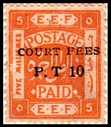 C34a
C34a
a) Lines of overprint 2mm apart vertically
C31. 1p on 1m brown
C32. 2p on 2m green
C33. 5p on 4m red
C34. 10p on 5m orange
a. No full stop after T
C35. 20p on 2p olive
C36. 50p on 9p ochre
C37. £E1 on 10p ultramarine
C31. 1p on 1m brown
C32. 2p on 2m green
C33. 5p on 4m red
C34. 10p on 5m orange
a. No full stop after T
C35. 20p on 2p olive
C36. 50p on 9p ochre
C37. £E1 on 10p ultramarine
b) Lines of overprint 5mm apart vertically

C46a (detail)
C41. 1p on 1p indigo (opt in silver) (perf 14)
C42. 2p on 2m green
C43. 5p on 1m brown
C44. 10p on 2m green (perf 14)
C45. 20p on 1m brown
C46. 50p on 1m brown
a. Two full stops between P and T in surcharge
C47. £1 on 2m green
Notes:
1. The letters P.T. on C31/36 exist in two different types, one slightly taller than the other. Both types occur in the same sheet and can be found as se-tenant pairs.
2. Wallerstein lists 1p on 2m, 1p on 10m and 1p on 10p values but I do believe these were issued.
3. Wallerstein lists the variety 'No full stop after T in P.T.' on my C31, C33, C34, C45 and C46. I have not seen this.
4. The denomination is shown as £E1 on C37 and as £1 on C47.
C42. 2p on 2m green
C43. 5p on 1m brown
C44. 10p on 2m green (perf 14)
C45. 20p on 1m brown
C46. 50p on 1m brown
a. Two full stops between P and T in surcharge
C47. £1 on 2m green
Notes:
1. The letters P.T. on C31/36 exist in two different types, one slightly taller than the other. Both types occur in the same sheet and can be found as se-tenant pairs.
2. Wallerstein lists 1p on 2m, 1p on 10m and 1p on 10p values but I do believe these were issued.
3. Wallerstein lists the variety 'No full stop after T in P.T.' on my C31, C33, C34, C45 and C46. I have not seen this.
4. The denomination is shown as £E1 on C37 and as £1 on C47.
1923 (earliest recorded usage). New large typeset design inscribed Palestine Court Fees in Arabic, English and Hebrew. 28 x 31½ mm. English inscription and figures of value in seriffed font. No currency indicated. Perf 11½. Wmk Script Cypher (upright or inverted).
C51. 1p scarlet
C52. 5p blue
C53. 10p brown-orange
C54. 20p brick-red
C55. 50p black
C56. 100p green
Notes:
1. Four different clichés were used to produce the printing plate, giving rise to a number of minor font varieties within the sheet. These are described and illustrated by Bale.
2. All values are known with watermark upright. I have also seen the 5p, 20p, 50p and 100p with watermark inverted.
C51. 1p scarlet
C52. 5p blue
C53. 10p brown-orange
C54. 20p brick-red
C55. 50p black
C56. 100p green
Notes:
1. Four different clichés were used to produce the printing plate, giving rise to a number of minor font varieties within the sheet. These are described and illustrated by Bale.
2. All values are known with watermark upright. I have also seen the 5p, 20p, 50p and 100p with watermark inverted.
1923-24 (earliest recorded usage). Similar to previous issue but redrawn with English inscription and figures of value in bold sans-serif font, and currency now specified as piastres (ghirsh غرش in Arabic). 20p inscribed COURT FEES; all other values inscribed COURTS FEES with final S. Perf 11. Wmk Script Cypher (upright or inverted).
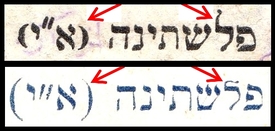
Two types of Hebrew inscription: C61/65a (top) and C66/67 (bottom)
a) Small brackets in lower line of Hebrew text and upright stroke at top of letter lamed (1923)
C61. 1p scarlet
C62. 5p blue
C63. 10p brown-orange
C64. 20p red
C65. 50p black
a. Wmk Block Cypher (sideways) (c1925)
C61. 1p scarlet
C62. 5p blue
C63. 10p brown-orange
C64. 20p red
C65. 50p black
a. Wmk Block Cypher (sideways) (c1925)
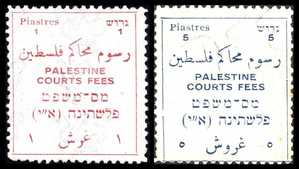 C66/67
C66/67
b) Hebrew text redrawn with larger brackets and top of letter lamed bent over (1924)
C66. 1p scarlet
C67. 5p blue
Notes:
C66. 1p scarlet
C67. 5p blue
Notes:
1. The Arabic inscription for piastre on this issue is described by Bale as 'wrong', but in fact these stamps reflect the standard spelling then in use throughout the Arab world, with the initial letter being غ (gh). The revised spelling with initial ق (q) was adopted some time in the 1920s.
2. Barefoot lists a 100p in this type, but I have not seen this. Wallerstein too lists the 100p but on Block Cypher watermark (PWP 2), though his illustration for this shows the Arabic spelling qirsh so this looks like an erroneous doubling for my C86.
3. Wallerstein lists a variety on the 1p where the words COURTS is misprinted as COUPTS. It is not known whether this is constant.
4. The Script Cypher watermark can be found either upright or inverted. So far I have seen the following:
c1925. As previous issue (Hebrew inscription as C66/67) but Arabic spelling of piastres now amended to qirsh قرش, and English inscription now shown as COURTS FEES on all values. Perf 11.
2. Barefoot lists a 100p in this type, but I have not seen this. Wallerstein too lists the 100p but on Block Cypher watermark (PWP 2), though his illustration for this shows the Arabic spelling qirsh so this looks like an erroneous doubling for my C86.
3. Wallerstein lists a variety on the 1p where the words COURTS is misprinted as COUPTS. It is not known whether this is constant.
4. The Script Cypher watermark can be found either upright or inverted. So far I have seen the following:
- Wmk upright: Hebrew original 1p, 10p
- Wmk inverted: Hebrew original 1p, 5p, 20p, 50p; Hebrew redrawn 1p, 5p
c1925. As previous issue (Hebrew inscription as C66/67) but Arabic spelling of piastres now amended to qirsh قرش, and English inscription now shown as COURTS FEES on all values. Perf 11.
a) Wmk Script Cypher (sideways)
C71. 1p carmine
C72. 5p blue
C73. 10p orange
C74. 20p orange-red
C75. 50p black
C76. 100p green
Note: the watermark can be found sideways with the crown pointing to either the right or the left (as seen from the back of the stamp). So far I have seen the 20p with crown pointing left, and the remaining values with crown to right.
C71. 1p carmine
C72. 5p blue
C73. 10p orange
C74. 20p orange-red
C75. 50p black
C76. 100p green
Note: the watermark can be found sideways with the crown pointing to either the right or the left (as seen from the back of the stamp). So far I have seen the 20p with crown pointing left, and the remaining values with crown to right.
b) Watermark Block Cypher (sideways)
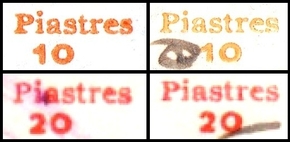
10p and 20p with figures of value placed to left or centred
C81. 1p carmine
C82. 5p blue
C83. 10p orange
C84. 20p orange-red
C85. 50p black
C86. 100p green
Notes:
1. Wallerstein records the 1p value with variety S missing in FEES, which I have not seen. He also records minor broken frame varieties on the 1p and 20p. Both Bale and Wallerstein record values imperforate between the stamp and the margin. Barefoot lists the 50p with only one dot in the letter ي in the Arabic word for Palestine (towards top left of stamp).
2. The figures of value at top left are usually placed to the left of centre relative to the word Piastres, such that the zero appears below the letters 'as'. However the 5p, 10p, 20p and 50p values can also be found with the figures centred relative to Piastres, as shown in the illustration above right. This variety can be found se-tenant with normal.
3. Bale indicates that all values except the 100p are known with rough perforations.
4. The watermark can be found sideways with the crown pointing to either the right or the left (as seen from the back of the stamp). All values are known with crown pointing left, and all values except the 5p with crown to right.
C82. 5p blue
C83. 10p orange
C84. 20p orange-red
C85. 50p black
C86. 100p green
Notes:
1. Wallerstein records the 1p value with variety S missing in FEES, which I have not seen. He also records minor broken frame varieties on the 1p and 20p. Both Bale and Wallerstein record values imperforate between the stamp and the margin. Barefoot lists the 50p with only one dot in the letter ي in the Arabic word for Palestine (towards top left of stamp).
2. The figures of value at top left are usually placed to the left of centre relative to the word Piastres, such that the zero appears below the letters 'as'. However the 5p, 10p, 20p and 50p values can also be found with the figures centred relative to Piastres, as shown in the illustration above right. This variety can be found se-tenant with normal.
3. Bale indicates that all values except the 100p are known with rough perforations.
4. The watermark can be found sideways with the crown pointing to either the right or the left (as seen from the back of the stamp). All values are known with crown pointing left, and all values except the 5p with crown to right.
1928 (earliest recorded usage). As previous issue but currency now expressed in Mils. Perf 11 x 11¼. Wmk Block Cypher (sideways).
C91. 2m chocolate
C92. 3m mauve
C93. 5m olive
C94. 10m carmine
C95. 50m blue
C96. 80m yellow
C97. 100m orange
C98. 200m orange-red
C99. 500m black
Notes:
1. With the exception of the 3m, all the above values are known with both types of sideways watermark, ie with the crown pointing to either the right or the left (as seen from the back of the stamp), with no apparent difference in scarcity between the two types. To date I have found the 3m only with crown pointing to left.
2. Barefoot lists a 20m value but this seems to be an error.
3. Bale lists the following varieties, none of which I have seen: 5m imperf between stamp and left margin, 5m in a pair with gutter between, 200m and 500m with missing horizontal or vertical perforations, 500m in a horizontal pair vertically imperforate between.
4. Bale indicates that all values except the 2m and 3m can be found with rough perforations.
C91. 2m chocolate
C92. 3m mauve
C93. 5m olive
C94. 10m carmine
C95. 50m blue
C96. 80m yellow
C97. 100m orange
C98. 200m orange-red
C99. 500m black
Notes:
1. With the exception of the 3m, all the above values are known with both types of sideways watermark, ie with the crown pointing to either the right or the left (as seen from the back of the stamp), with no apparent difference in scarcity between the two types. To date I have found the 3m only with crown pointing to left.
2. Barefoot lists a 20m value but this seems to be an error.
3. Bale lists the following varieties, none of which I have seen: 5m imperf between stamp and left margin, 5m in a pair with gutter between, 200m and 500m with missing horizontal or vertical perforations, 500m in a horizontal pair vertically imperforate between.
4. Bale indicates that all values except the 2m and 3m can be found with rough perforations.
Devair Resmi
For an identification guide to the small typeset issues, see top of this page.
To see how my listing of these issues relates to other published catalogues of Palestine revenues, please see the supplementary information page here.
To see how my listing of these issues relates to other published catalogues of Palestine revenues, please see the supplementary information page here.
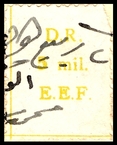
D6
c1919. Typeset issue inscribed D.R. / E.E.F. Type B: D.R. in wide letters (overall width 7 mm). Rough perf 11. Wmk Script Cypher.
D6. 5m yellow
Note: so far I have seen this stamp with upright watermark only.
c1920. New typeset designs with top and bottom lines of inscription reading O.P.D.A. / Devair. Perf 10½-11½. Wmk Script Cypher (upright or inverted).
a) Type C: small font (O.P.D.A. 12 mm wide), mil in lower case
D11. 5m blue
b) Type D: large font (O.P.D.A. 14 mm wide), Mil with capital M
D16. 5m blue (full stop after Mil)
D17. 5m blue (no full stop after Mil)
Notes:
1. Bale, Wallerstein and Barefoot list a 5m red similar to the above issue, but I have not seen this and believe it may be an error. Barefoot also lists a 5m green with Devair at top and EEF at foot, but I have not seen this recorded elsewhere
2. The watermark can be found upright or inverted on all the above stamps.
3. It is possible that the Type D stamp may exist on Block Cypher paper but this has not been recorded to date.
a) Type C: small font (O.P.D.A. 12 mm wide), mil in lower case
D11. 5m blue
b) Type D: large font (O.P.D.A. 14 mm wide), Mil with capital M
D16. 5m blue (full stop after Mil)
D17. 5m blue (no full stop after Mil)
Notes:
1. Bale, Wallerstein and Barefoot list a 5m red similar to the above issue, but I have not seen this and believe it may be an error. Barefoot also lists a 5m green with Devair at top and EEF at foot, but I have not seen this recorded elsewhere
2. The watermark can be found upright or inverted on all the above stamps.
3. It is possible that the Type D stamp may exist on Block Cypher paper but this has not been recorded to date.
c1920. EEF typographed issue inscribed Postage Paid overprinted O.P.D.A. DEVAIR and surcharged in Egyptian currency. Perf 14½ x 14. Wmk Script Cypher.
a) Overprint in seriffed font, value shown as 5 m-m
D21. 5m on 5m orange
b) Overprint in in sans-serif font, value shown as 5 Mill
D26. 5m on 5m orange
Notes:
1. In addition to the above Bale lists a 10p value overprinted in sans-serif font. I have not seen this.
2. Bale notes that D26 can be found with rough perforations.
a) Overprint in seriffed font, value shown as 5 m-m
D21. 5m on 5m orange
b) Overprint in in sans-serif font, value shown as 5 Mill
D26. 5m on 5m orange
Notes:
1. In addition to the above Bale lists a 10p value overprinted in sans-serif font. I have not seen this.
2. Bale notes that D26 can be found with rough perforations.
Hejaz Railway
For an identification guide to the small typeset issues, see top of this page.
To see how my listing of these issues relates to other published catalogues of Palestine revenues, please see the supplementary information page here.
To see how my listing of these issues relates to other published catalogues of Palestine revenues, please see the supplementary information page here.
Late 1918 or early 1919 (according to Bale). Typeset issue inscribed H.J.Z. / E.E.F. Type A: each stamp approx 20 x 24 mm, H.J.Z. in narrow letters with slight serifs (overall width 8½ mm). Denomination shown as mill(s) with double L or p.t. in lower case with stops. Imperf. Wmk Script Cypher (upright).
H1. 5m green
H2. 1p green
H3. 2p green
H4. 5p green
Surcharged 5 Mill with bar through original value:
H7. 5m on 2p green
Notes:
1. So far I have seen the above values with upright watermark only.
2. Bale, Wallerstein and Barefoot all list a 1p on 2p surcharge similar to H7, and Wallerstein additionally lists a 5p on 2p (possibly an error for 5m on 2p). I have not seen either of these. For a similar surcharge on Type B, see H21 below.
3. The inscription HJZ on this and subsequent issues may be an abbreviation for Hejaz Jordan Zone, or may be a transliteration of the Arabic consonants hjz, ie simply Hejaz.
H1. 5m green
H2. 1p green
H3. 2p green
H4. 5p green
Surcharged 5 Mill with bar through original value:
H7. 5m on 2p green
Notes:
1. So far I have seen the above values with upright watermark only.
2. Bale, Wallerstein and Barefoot all list a 1p on 2p surcharge similar to H7, and Wallerstein additionally lists a 5p on 2p (possibly an error for 5m on 2p). I have not seen either of these. For a similar surcharge on Type B, see H21 below.
3. The inscription HJZ on this and subsequent issues may be an abbreviation for Hejaz Jordan Zone, or may be a transliteration of the Arabic consonants hjz, ie simply Hejaz.
1919. Type B: H.J.Z. in wider letters (overall width 9½ mm) and the tail of the letter J below the level of the full stops. The denomination of the 5m value now correctly spelt mil with single L, piastre again shown as p.t. in lower case with stops. Wmk Script Cypher.
a) Imperf (mid-1919 according to Bale)
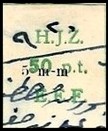
H21
H11. 5m green
H12. 1p green
H13. 2p green
H14. 5p green
H16. 20p green
[H17. 50p green]
Surcharged 5 m-m without bar through original value:
H21. 5m on 50p green
Notes:
1. I have seen the 50p value (H17) only with surcharge but assume it exists without.
2. Wallerstein does not list this series at all. Bale lists all the above values plus the 1 L.E. (=£1), and the 2p with value missing and the 5m with variety mli instead of mil. Wallerstein and Barefoot both list a 5m on 2p surcharge similar to H21. I have not seen any of these.
3. The watermark can be found upright, inverted or sideways with the crown pointing to either the right or the left (as seen from the back of the stamp). So far I have seen the following:
H12. 1p green
H13. 2p green
H14. 5p green
H16. 20p green
[H17. 50p green]
Surcharged 5 m-m without bar through original value:
H21. 5m on 50p green
Notes:
1. I have seen the 50p value (H17) only with surcharge but assume it exists without.
2. Wallerstein does not list this series at all. Bale lists all the above values plus the 1 L.E. (=£1), and the 2p with value missing and the 5m with variety mli instead of mil. Wallerstein and Barefoot both list a 5m on 2p surcharge similar to H21. I have not seen any of these.
3. The watermark can be found upright, inverted or sideways with the crown pointing to either the right or the left (as seen from the back of the stamp). So far I have seen the following:
- Wmk upright: 5m
- Wmk inverted: 5m, 2p, 5p, 20p
- Crown pointing right: 5m
- Crown pointing left: 1p, 2p, 5p
 H31a (detail)
H31a (detail)
b) Rough perf 11
H31. 5m green
a. Error mli for mil
H32. 1p green
H33. 2p green
H34. 5p green
Notes:
1. Both Bale and Wallerstein list a 20p value from this series; Wallerstein additionally has a 50p and £1, plus a 5m in light blue. Barefoot lists the 20p, 50p and £1. I have not seen any of these values.
2. I have so far seen the above stamps with watermark upright only.
H31. 5m green
a. Error mli for mil
H32. 1p green
H33. 2p green
H34. 5p green
Notes:
1. Both Bale and Wallerstein list a 20p value from this series; Wallerstein additionally has a 50p and £1, plus a 5m in light blue. Barefoot lists the 20p, 50p and £1. I have not seen any of these values.
2. I have so far seen the above stamps with watermark upright only.
c1919. Type C: denomination on piastre values now shown as P.T. in capitals with stops, and redrawn figure 5 on 5m value (see enlargement below right). H.J.Z. 9½ mm wide (H41/43) or in smaller letters with overall width 8 mm (H44/46). The tail of the letter J and the figure 5 on 5m value are below the level of the full stops. Perf 10½-11½. Wmk Script Cypher (upright, inverted or sideways).
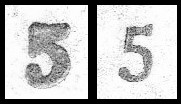
Figure 5 as found on H31 (left) and H41 (right)
H41. 5m green
H42. 1p green
H43. 1p red
H44. 2p green
H45. 2p blue
H46. 5p brown-orange
Notes:
1. Wallerstein conflates this series with the perforated Type B issue (my H31/33).
2. Bale lists a 5m with variety '5 mli', which I have not seen on this issue. I believe that Bale's listing is mistaken since it seems unlikely that the same error would exist on both H31 and H41, which were printed from different types.
3. The watermark can be found either upright or inverted on all values. I have also seen the 5m with watermark sideways with crown to right.
4. Specialists may wish to distinguish two separate perforations on this issue (11 x 11 and 11½ x 11½), plus 'rough perforations', all of which are listed separately by Bale. He also lists the 2p green perf 11 x 14, which I have not seen.
5. There are minor variations in letter spacing on a number of values.
H42. 1p green
H43. 1p red
H44. 2p green
H45. 2p blue
H46. 5p brown-orange
Notes:
1. Wallerstein conflates this series with the perforated Type B issue (my H31/33).
2. Bale lists a 5m with variety '5 mli', which I have not seen on this issue. I believe that Bale's listing is mistaken since it seems unlikely that the same error would exist on both H31 and H41, which were printed from different types.
3. The watermark can be found either upright or inverted on all values. I have also seen the 5m with watermark sideways with crown to right.
4. Specialists may wish to distinguish two separate perforations on this issue (11 x 11 and 11½ x 11½), plus 'rough perforations', all of which are listed separately by Bale. He also lists the 2p green perf 11 x 14, which I have not seen.
5. There are minor variations in letter spacing on a number of values.
c1919. Type D: H.J.Z. in new font (overall width 12 mm) with all letters aligned at base. Denomination on 5m now shown as Mil with capital M; piastre shown as P.T. in capitals with stops, as on H41/46. Perf 11. Wmk Script Cypher (upright, inverted or sideways).
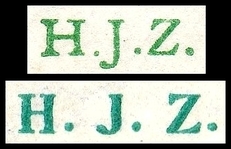
Letters 'H.J.Z.' as seen on H41/46 (top) or H51/53 (below)
H51. 5m green
H52. 1p green
H53. 2p blue
Notes:
H52. 1p green
H53. 2p blue
Notes:
1. Bale and Barefoot also list 2½m, 5p and 1p values in red and perf 10½ or 11, though I have not seen these. Wallerstein lists a 5p in brown or gold-brown, but I take this to be an error for my H46 or H74.
2. The watermark can be found upright, inverted or sideways with the crown pointing to either the right or the left on all values.
3. Bale distinguishes clean from rough perforations on the 5m and 1p though I have seen no examples with rough perfs.
4. For similar stamps but with Block Cypher watermark, see H71/76 below.
2. The watermark can be found upright, inverted or sideways with the crown pointing to either the right or the left on all values.
3. Bale distinguishes clean from rough perforations on the 5m and 1p though I have seen no examples with rough perfs.
4. For similar stamps but with Block Cypher watermark, see H71/76 below.
c1920. EEF typographed issue inscribed Postage Paid overprinted H.J.Z. and surcharged in Egyptian currency. Perf 14½ x 14. Wmk Script Cypher.
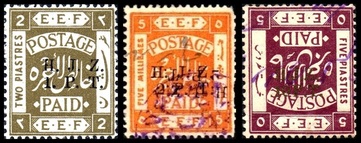
Surcharge varieties H63a, H64a and H66a
a) H.J.Z. overprint in seriffed font, lines of overprint 2mm apart vertically, denomination shown as m-m or P.T. with figure of value preceding
H61. 5m on 5m orange
H62. 1p on 1p indigo (surch in red)
H63. 1p on 2p olive
a. Full stop after 1 in surcharge
H64. 2p on 5m orange
(letters P.T. 3 mm apart)
a. Surcharge double, one inverted
b. Letters P.T. 1 mm apart
H65. 2p on 2p olive
H66. 10p on 5p purple (surch in gold)
a. Surcharge inverted
Notes:
1. The spacing of the letters H.J.Z. and P.T. in the overprint is wide on H63/64 and narrow on H61/62 and H65/66. H64b combines elements of both, with wide spacing (9½ mm wide) on H.J.Z. but narrow spacing (1 mm) on P.T. Wallerstein lists the 2p on 5m with variety no full stop after the letter Z in HJZ, and the 2p on 2p and 50p on 5m (my H69 below) with no stop after J.
2. Bale also lists the following: 10p on 5p purple surcharged in silver, 10p on 5p purple with gold surcharge double, 25p on 5m orange. This last may be an erroneous doubling for my H68 below. Both Wallerstein and Barefoot list a 2p on 1p surcharged in red, 50p on 5m (presumably of similar type to H61/66) and double surcharges on both the 1p on 2p and the 2p on 5m. I have not seen any of these.
H61. 5m on 5m orange
H62. 1p on 1p indigo (surch in red)
H63. 1p on 2p olive
a. Full stop after 1 in surcharge
H64. 2p on 5m orange
(letters P.T. 3 mm apart)
a. Surcharge double, one inverted
b. Letters P.T. 1 mm apart
H65. 2p on 2p olive
H66. 10p on 5p purple (surch in gold)
a. Surcharge inverted
Notes:
1. The spacing of the letters H.J.Z. and P.T. in the overprint is wide on H63/64 and narrow on H61/62 and H65/66. H64b combines elements of both, with wide spacing (9½ mm wide) on H.J.Z. but narrow spacing (1 mm) on P.T. Wallerstein lists the 2p on 5m with variety no full stop after the letter Z in HJZ, and the 2p on 2p and 50p on 5m (my H69 below) with no stop after J.
2. Bale also lists the following: 10p on 5p purple surcharged in silver, 10p on 5p purple with gold surcharge double, 25p on 5m orange. This last may be an erroneous doubling for my H68 below. Both Wallerstein and Barefoot list a 2p on 1p surcharged in red, 50p on 5m (presumably of similar type to H61/66) and double surcharges on both the 1p on 2p and the 2p on 5m. I have not seen any of these.
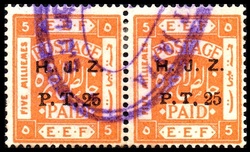
H68 with P.T. in tall (left) or short (right) letters in se-tenant pair
b) H.J.Z. overprint in in sans-serif font, lines of overprint 4 mm apart vertically, value shown as P.T. followed by figures of value
H67. 10p on 5m orange
H68. 25p on 5m orange
H69. 50p on 5m orange
Notes:
1. Bale lists the 10p on 5m with inverted surcharge, but I have not seen this.
2. Minor variations in font can be found, such as 'P.T.' in tall or short letters as illustrated above right.
H67. 10p on 5m orange
H68. 25p on 5m orange
H69. 50p on 5m orange
Notes:
1. Bale lists the 10p on 5m with inverted surcharge, but I have not seen this.
2. Minor variations in font can be found, such as 'P.T.' in tall or short letters as illustrated above right.
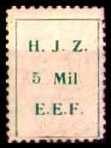 H71a
H71a
c1924. Type D typeset issue reprinted with watermark changed to Block Cypher (sideways) and each value now in a different colour. Perf 11.
H71. 5m green (full stop after Mil)
a. No full stop after Mil
H72. 1p red
H73. 2p blue
H74. 5p orange
H75. 10p purple
H76. 25p silver
Notes:
1. Bale, Wallerstein and Barefoot all list a 50p brown but I have not seen this. Wallerstein and Barefoot also list a 1p green (in various shades), but I believe this to be an error for my H52 on Script Cypher watermark.
2. All the above values are known with both types of sideways watermark, ie with the crown pointing to either the right or the left (as seen from the back of the stamp), with no apparent difference in scarcity between the two types.
3. Bale notes that the 5m, 1p, 10p and 25p can be found with rough perforations.
H71. 5m green (full stop after Mil)
a. No full stop after Mil
H72. 1p red
H73. 2p blue
H74. 5p orange
H75. 10p purple
H76. 25p silver
Notes:
1. Bale, Wallerstein and Barefoot all list a 50p brown but I have not seen this. Wallerstein and Barefoot also list a 1p green (in various shades), but I believe this to be an error for my H52 on Script Cypher watermark.
2. All the above values are known with both types of sideways watermark, ie with the crown pointing to either the right or the left (as seen from the back of the stamp), with no apparent difference in scarcity between the two types.
3. Bale notes that the 5m, 1p, 10p and 25p can be found with rough perforations.
Immigration and Consular Fee
To see how my listing of these issues relates to other published catalogues of Palestine revenues, please see the supplementary information page here.
To see how my listing of these issues relates to other published catalogues of Palestine revenues, please see the supplementary information page here.
1923-27. EEF typographed issue overprinted (in black) Palestine in Arabic, English and Hebrew, now additionally overprinted for consular use or surcharged also. 10p value (I3) printed in sheets of 120, perf 15 x 14; others in sheets of 240, perf 14. Wmk Multiple Script CA. Printed and overprinted by Waterlow.
a) Overprinted I. & T. (= Immigration and Travel)
I1. 25p on 2m yellow (I. & T. plus surcharge in blue)
I2. 37p on 2m yellow (I. & T. plus surcharge in red)
b) Overprinted FEE
I3. 10p ultramarine (FEE in red) (1926)
I5. 50p on 2m yellow (FEE plus surcharge in red) (1926)
Notes:
1. Printing details for this and other issues can be found on a dedicated page here.
2. The entry for Req 1663/3 in the Requisition book describes the stamp as 2m overprinted in blue "Fee 25 P.T." - ie similar to my I3/5. Both Bale and Wallerstein list this stamp, perhaps on the basis of the Requisition book entry, but I have never seen an example. However it is possible that the Crown Agents description was not a literal description of the overprint, and that Req 1663/3 was actually a reprint of I1 (inscribed I. & T.)
a) Overprinted I. & T. (= Immigration and Travel)
I1. 25p on 2m yellow (I. & T. plus surcharge in blue)
I2. 37p on 2m yellow (I. & T. plus surcharge in red)
b) Overprinted FEE
I3. 10p ultramarine (FEE in red) (1926)
I5. 50p on 2m yellow (FEE plus surcharge in red) (1926)
Notes:
1. Printing details for this and other issues can be found on a dedicated page here.
2. The entry for Req 1663/3 in the Requisition book describes the stamp as 2m overprinted in blue "Fee 25 P.T." - ie similar to my I3/5. Both Bale and Wallerstein list this stamp, perhaps on the basis of the Requisition book entry, but I have never seen an example. However it is possible that the Crown Agents description was not a literal description of the overprint, and that Req 1663/3 was actually a reprint of I1 (inscribed I. & T.)
Impressed revenue stamps
1927-48 (recorded usage). Sprig of olive (national emblem) in frames of different shapes, all 25 to 30 mm across (except 7m narrower oval type), each incorporating a die letter, usually above right of centre. Inscribed PALESTINE STAMP DUTY in English, Arabic and Hebrew. All designs incorporate date plugs, with the year plug on the right. The recorded dates of use are shown in brackets.
a) Colourless (1927-48)
Z1b. 7m colourless (B) (1927-48)
Z2c. 10m colourless (C)
Z6b. 50m colourless (B) (1946)
Z7b. 100m colourless (B) (1946)
Z1b. 7m colourless (B) (1927-48)
Z2c. 10m colourless (C)
Z6b. 50m colourless (B) (1946)
Z7b. 100m colourless (B) (1946)
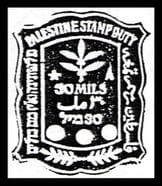 30m proof (image from Barber)
30m proof (image from Barber)
b) Vermilion (1930-46)
Z11a. 5m vermilion (A) (1946?)
Z12a. 10m vermilion (A) (1940-45)
Z13a. 20m vermilion (A) (1933-46)
b. Die B (1934)
c. Die C (1942)
Z15a. 40m vermilion (A) (1932-40)
b. Die B (1934)
Z16a. 50m vermilion (A) (1940)
b. Die B (1933)
c. Die C (1937-42)
Z17a. 100m vermilion (A) (1933-46)
b. Die B (1933-34)
c. Die C (1937-42)
Z18a. 250m vermilion (A) (1938)
b. Die B (1930?)
c. Die C (1935-43)
Z19a. 500m vermilion (A) (1931-35)
b. Die B (1931-34)
c. Die C (1934-43)
d. Die D (1941)
Z20a. £1 vermilion (A) (1933)
c. Die C (1937-43)
Z21c. £5 vermilion (C) (1934)
Z11a. 5m vermilion (A) (1946?)
Z12a. 10m vermilion (A) (1940-45)
Z13a. 20m vermilion (A) (1933-46)
b. Die B (1934)
c. Die C (1942)
Z15a. 40m vermilion (A) (1932-40)
b. Die B (1934)
Z16a. 50m vermilion (A) (1940)
b. Die B (1933)
c. Die C (1937-42)
Z17a. 100m vermilion (A) (1933-46)
b. Die B (1933-34)
c. Die C (1937-42)
Z18a. 250m vermilion (A) (1938)
b. Die B (1930?)
c. Die C (1935-43)
Z19a. 500m vermilion (A) (1931-35)
b. Die B (1931-34)
c. Die C (1934-43)
d. Die D (1941)
Z20a. £1 vermilion (A) (1933)
c. Die C (1937-43)
Z21c. £5 vermilion (C) (1934)
c) Blue (1933-43)
Z33a. 20m blue (A) (1941)
d. Die D (1943)
Z35a. 40m blue (A) (1942-43)
c. Die C (1933)
Z36a. 50m blue (A) (1941)
Z37a. 100m blue (A) (1941-43?)
c. Die C (1933)
Z40a. £1 blue (A) (1943)
d. Die D (1943)
Notes:
1. In addition to these values, Barber and Wallerstein list the 30m in upright rectangular type. Barber illustrates die proofs of the full set including this value, which is illustrated above right.
2. Barber quotes research by one Chester S Callen which states that the die letters correspond to different court locations, with A for Jerusalem, B for Jaffa, C for Haifa and D (after 1934) for Tel Aviv. Barber lists A, B, C and D for each value, indicating that all should be possible, but this is not to say that all were issued.
3. The significance of the different colours is not yet clear. Wallerstein lists the 10m, 250m, 500m and £5 in blue, albino impressions of the 250m and 500m, and the 250m, 500m and £1 in light violet. Barber mentions the use of magenta ink, and footnotes the existence of a set handstamped PENALTY in violet. I have not seen any of these.
Z33a. 20m blue (A) (1941)
d. Die D (1943)
Z35a. 40m blue (A) (1942-43)
c. Die C (1933)
Z36a. 50m blue (A) (1941)
Z37a. 100m blue (A) (1941-43?)
c. Die C (1933)
Z40a. £1 blue (A) (1943)
d. Die D (1943)
Notes:
1. In addition to these values, Barber and Wallerstein list the 30m in upright rectangular type. Barber illustrates die proofs of the full set including this value, which is illustrated above right.
2. Barber quotes research by one Chester S Callen which states that the die letters correspond to different court locations, with A for Jerusalem, B for Jaffa, C for Haifa and D (after 1934) for Tel Aviv. Barber lists A, B, C and D for each value, indicating that all should be possible, but this is not to say that all were issued.
3. The significance of the different colours is not yet clear. Wallerstein lists the 10m, 250m, 500m and £5 in blue, albino impressions of the 250m and 500m, and the 250m, 500m and £1 in light violet. Barber mentions the use of magenta ink, and footnotes the existence of a set handstamped PENALTY in violet. I have not seen any of these.
Jerusalem Municipality
To see how my listing of these issues relates to other published catalogues of Palestine revenues, please see the supplementary information page here.
To see how my listing of these issues relates to other published catalogues of Palestine revenues, please see the supplementary information page here.
c1918. Turkish Rental Contracts stamps of 1883 handstamped J.M. (14 x 6 mm) in violet-black. Perf 12 x 11. Ottoman currency: 40 paras (pa) = 1 piastre (pi). Note: each stamp consists of two parts, inscribed (in Turkish) Tenant and Landlord on the left- and right-hand halves respectively.
M1. 10pa on 2pa grey-blue (original surcharge in red)
M3. 2pa red-brown
Notes:
1. In addition to the above value Bale also lists the 2pa as M1 but without the red surcharge, plus similar 3pa and 5pa values and a 2pa imperforate. Wallerstein lists the same stamps plus a 10pa and 100pa. I have not seen any of these.
2. No forgeries of the J.M. overprint have been recorded so far but care should be exercised in buying stamps of this issue.
M1. 10pa on 2pa grey-blue (original surcharge in red)
M3. 2pa red-brown
Notes:
1. In addition to the above value Bale also lists the 2pa as M1 but without the red surcharge, plus similar 3pa and 5pa values and a 2pa imperforate. Wallerstein lists the same stamps plus a 10pa and 100pa. I have not seen any of these.
2. No forgeries of the J.M. overprint have been recorded so far but care should be exercised in buying stamps of this issue.
Labels
c1920s-30s. Control Coupons for the Singer Sewing Machine Company. Inscribed in English with currency in Mils. 48 x 16 mm. Roulette 12½ x 5½, imperf at sheet edges. No watermark. Serial number machine-stamped in black.
a) No inscription at lower left
L1. 100m red and black
L2. 150m blue and black
L3. 200m yellow and black
L4. 500m green and black
L1. 100m red and black
L2. 150m blue and black
L3. 200m yellow and black
L4. 500m green and black
b) With the words A/c No and a dotted line at lower left
L6. 100m red and black
L7. 150m blue and black
L8. 200m yellow and black
L9. 500m green and black
Notes:
1. Earliest recorded usage: 1933 (L8). It is not known whether L1/4 or L6/9 were issued first.
2. Although this design does not feature the country name, these adhesives can be identified as Palestinian by the trilingual (English, Arabic and Hebrew) inscriptions in the value tablet. Wallerstein lists (but does not illustrate) similar stamps but denominated in piastres (10p, 15p and 50p). I believe these are the issue for Egypt with inscriptions in French and Arabic.
3. Singer labels such as these are known for numerous other territories including Malta.
L6. 100m red and black
L7. 150m blue and black
L8. 200m yellow and black
L9. 500m green and black
Notes:
1. Earliest recorded usage: 1933 (L8). It is not known whether L1/4 or L6/9 were issued first.
2. Although this design does not feature the country name, these adhesives can be identified as Palestinian by the trilingual (English, Arabic and Hebrew) inscriptions in the value tablet. Wallerstein lists (but does not illustrate) similar stamps but denominated in piastres (10p, 15p and 50p). I believe these are the issue for Egypt with inscriptions in French and Arabic.
3. Singer labels such as these are known for numerous other territories including Malta.
Ottoman Public Debt Administration
For an identification guide to the small typeset issues, see top of this page.
To see how my listing of these issues relates to other published catalogues of Palestine revenues, please see the supplementary information page here.
To see how my listing of these issues relates to other published catalogues of Palestine revenues, please see the supplementary information page here.
July 1918 (see note 1). Postage and revenue stamp of Great Britain (portrait of King George V) overprinted O.P.D.A. (13 mm wide) and surcharged in Egyptian currency. 18½ x 22½ mm. Perf 15 x 14. Wmk Script Cypher.
O1. 5m on 1d red
O2. 1p on 1d red
Notes: 1. Wallerstein reproduces a letter dated 7 July 1918 from the Director of Postal Service in Jerusalem, acknowledging receipt of 6000 examples of each value. It is assumed that they were issued the same month.
2. The 5m value is known with cylinder K18.
O1. 5m on 1d red
O2. 1p on 1d red
Notes: 1. Wallerstein reproduces a letter dated 7 July 1918 from the Director of Postal Service in Jerusalem, acknowledging receipt of 6000 examples of each value. It is assumed that they were issued the same month.
2. The 5m value is known with cylinder K18.
Early 1919 (according to Wallerstein). Typeset issue inscribed O.P.D.A. / E.E.F. Type A: each stamp approx 20 x 24 mm, O.P.D.A. in narrow letters with slight serifs (overall width 12½ mm). Denomination shown as mill(s) with double L or p.t. in lower case with stops. Imperf. Wmk Script Cypher (upright or inverted).
O11. ½m orange
O15. 5m blue
O16. 5m orange
O17. 1p orange
O18. 2p orange
O19. 2½p orange
O20. 5p orange
Notes:
1. Wallerstein states that these stamps were produced at the Greek Orthodox Convent in Jerusalem. I presume that the same printers must have been responsible for the Type A imperf stamps for Court Fee and Hejaz Railway.
2. Bale also lists the following values: 1m, 2m, 2½m, 10p, 15p, 50p, all in yellow or yellow-orange. Wallerstein lists the same plus the 2½m blue and the 20p orange-brown. Barefoot lists a variety with mill instead of mills on the 5m orange. I have not seen any of these values.
3. The watermark can be found either upright or inverted. So far I have seen the following:
Mid-1919 (according to Wallerstein). Type B: O.P.D.A. in wider letters (overall width 14 mm) and mil spelt with either single or double L as indicated. Piastre again shown as p.t. in lower case with stops. Watermark Script Cypher.
O11. ½m orange
O15. 5m blue
O16. 5m orange
O17. 1p orange
O18. 2p orange
O19. 2½p orange
O20. 5p orange
Notes:
1. Wallerstein states that these stamps were produced at the Greek Orthodox Convent in Jerusalem. I presume that the same printers must have been responsible for the Type A imperf stamps for Court Fee and Hejaz Railway.
2. Bale also lists the following values: 1m, 2m, 2½m, 10p, 15p, 50p, all in yellow or yellow-orange. Wallerstein lists the same plus the 2½m blue and the 20p orange-brown. Barefoot lists a variety with mill instead of mills on the 5m orange. I have not seen any of these values.
3. The watermark can be found either upright or inverted. So far I have seen the following:
- Wmk upright: ½m, 5m yellow-orange, 1p, 2½p, 5p
- Wmk inverted: 5m blue, 5m yellow-orange, 1p, 2p
Mid-1919 (according to Wallerstein). Type B: O.P.D.A. in wider letters (overall width 14 mm) and mil spelt with either single or double L as indicated. Piastre again shown as p.t. in lower case with stops. Watermark Script Cypher.
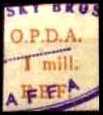 O23
O23
a) Imperf (mid-1919)
O21. ½ mill orange
O22. ½ mil orange
O23. 1 mill orange
O24. 1 mil orange
O25. 2½ mill orange
O26. 2½ mil orange
O28. 5 mill orange
O29. 5 mil orange
O30. 5 mil blue
O31. 1p orange
O33. 2p orange
O35. 2½p orange
O36. 5p orange
O37. 10p orange
O38. 15p orange
O39. 20p orange
Notes:
1. Bale and Wallerstein both list the 2½mil (single L) blue, 1p blue and 50p orange; Bale additionally lists a 1p orange with Arabic figure of value, and Wallerstein lists a 5m green and a 3p in brick-red. I have not seen any of these.
2. Wallerstein lists varieties on the 5m and 1p in which full stops are missing after the letters O or P in OPDA or after the p in p.t. Barefoot lists the 1p with no stop after the second E of EEF. I have not seen these.
3. The orange ink can be found in a range of shades from yellow-orange to orange-red, with Wallerstein listing cherry-red shades of the 1p, 2p, 5p and 10p plus a 2p red-brown. I formerly listed the 2p as yellow (as does Bale) though I have now seen this in other shades of orange and red. Some values can be found in a deep brown colour, which is probably the result of oxidation rather than a different printing.
4. The watermark can be found upright, inverted or sideways with the crown pointing to either the right or the left (as seen from the back of the stamp). So far I have seen the following:
O21. ½ mill orange
O22. ½ mil orange
O23. 1 mill orange
O24. 1 mil orange
O25. 2½ mill orange
O26. 2½ mil orange
O28. 5 mill orange
O29. 5 mil orange
O30. 5 mil blue
O31. 1p orange
O33. 2p orange
O35. 2½p orange
O36. 5p orange
O37. 10p orange
O38. 15p orange
O39. 20p orange
Notes:
1. Bale and Wallerstein both list the 2½mil (single L) blue, 1p blue and 50p orange; Bale additionally lists a 1p orange with Arabic figure of value, and Wallerstein lists a 5m green and a 3p in brick-red. I have not seen any of these.
2. Wallerstein lists varieties on the 5m and 1p in which full stops are missing after the letters O or P in OPDA or after the p in p.t. Barefoot lists the 1p with no stop after the second E of EEF. I have not seen these.
3. The orange ink can be found in a range of shades from yellow-orange to orange-red, with Wallerstein listing cherry-red shades of the 1p, 2p, 5p and 10p plus a 2p red-brown. I formerly listed the 2p as yellow (as does Bale) though I have now seen this in other shades of orange and red. Some values can be found in a deep brown colour, which is probably the result of oxidation rather than a different printing.
4. The watermark can be found upright, inverted or sideways with the crown pointing to either the right or the left (as seen from the back of the stamp). So far I have seen the following:
- Wmk upright: 2½mil, 5mill orange, 5mil orange, 5mil blue, 1p, 5p, 20p
- Wmk inverted: ½mill, ½mil, 1mil, 2½mil, 5mil orange, 5mil blue, 1p, 2½p, 5p, 10p, 15p, 20p
- Crown pointing right: 5mil orange
- Crown pointing left: 5mil blue
b) Rough perf 11 (earliest recorded usage June 1920)
O41. ½m yellow
O42. 2½m yellow
O43. 5m yellow
O44. 1p yellow
O45. 2p yellow
Notes:
1. The yellow can appear in shades from olive-green to yellow-orange. The 5m and 1p are also known in red-orange, which may be a different ink or a climatically affected yellow.
2. Bale, Wallerstein and Barefoot all list a 5p yellow from this series but I have not seen this. Wallerstein also lists the ½m, 2½m and 5p values in red and Barefoot a 1m red from this series but I believe these probably belong to the Type D issue (my O71/78 below).
3. The vast majority of examples have watermark upright, though the 5m is also known with watermark inverted. Wallerstein lists sideways watermark on the 2½m and inverted on the 2p but I have not seen these.
4. Barefoot lists the minor variety No stop after F of EEF on the 1p.
5. Bale distinguishes clean from rough perforations on all the above values though I have seen no examples with clean-cut perfs.
O41. ½m yellow
O42. 2½m yellow
O43. 5m yellow
O44. 1p yellow
O45. 2p yellow
Notes:
1. The yellow can appear in shades from olive-green to yellow-orange. The 5m and 1p are also known in red-orange, which may be a different ink or a climatically affected yellow.
2. Bale, Wallerstein and Barefoot all list a 5p yellow from this series but I have not seen this. Wallerstein also lists the ½m, 2½m and 5p values in red and Barefoot a 1m red from this series but I believe these probably belong to the Type D issue (my O71/78 below).
3. The vast majority of examples have watermark upright, though the 5m is also known with watermark inverted. Wallerstein lists sideways watermark on the 2½m and inverted on the 2p but I have not seen these.
4. Barefoot lists the minor variety No stop after F of EEF on the 1p.
5. Bale distinguishes clean from rough perforations on all the above values though I have seen no examples with clean-cut perfs.
Autumn 1919 (according to Wallerstein). Type C: similar to previous issue but all inscriptions in smaller font (O.P.D.A. overall width now 12mm), and denomination on piastre values now shown as P.T. (in capitals with stops). Perf 10½-11½. Wmk Script Cypher (upright or inverted).
O51. ½m red
O52. 1m red
O53. 2½m red
O54. 5m red
O55. 1p red
O56. 3p red
O57. 4p red
O58. 7½p red
O59. 15p red
O60. 20p red
O61. 25p red
O62. 50p red
Notes:
1. In addition to the above values Wallerstein lists the following: ½m, 2½m and 5m all in olive-green, 1p and 2p in yellow, 2p, 5p and 10p in red. Barefoot also lists the 2p and 10p red. None of these is recorded elsewhere with Type C small font, and I suspect they belong to Types B (olive-green / yellow) or D (red).
2. The watermark can be found either upright or inverted, with inverted being apparently more common. So far I have seen the following:
4. Specialists may wish to distinguish three separate perforations on this issue (11 x 11, 11½ x 11½ and 10½ x 10½), plus 'rough perforations', all of which are listed separately by Bale.
5. There are minor variations in spacing on a number of values. Wallerstein lists the 2½m, 5m and 25p with missing full stop after the letter A of OPDA.
6. Barefoot lists three stamps in this type but on Block Cypher paper: 2½m blue, 1p green and 1p red. These are not listed anywhere else and I have not seen them. I would be very keen to hear from any reader who can prove their existence.
O51. ½m red
O52. 1m red
O53. 2½m red
O54. 5m red
O55. 1p red
O56. 3p red
O57. 4p red
O58. 7½p red
O59. 15p red
O60. 20p red
O61. 25p red
O62. 50p red
Notes:
1. In addition to the above values Wallerstein lists the following: ½m, 2½m and 5m all in olive-green, 1p and 2p in yellow, 2p, 5p and 10p in red. Barefoot also lists the 2p and 10p red. None of these is recorded elsewhere with Type C small font, and I suspect they belong to Types B (olive-green / yellow) or D (red).
2. The watermark can be found either upright or inverted, with inverted being apparently more common. So far I have seen the following:
- Wmk upright: 1m, 2½m, 5m, 1p, 3p, 7½p, 15p, 20p, 50p
- Wmk inverted: ½m, 1m, 2½m, 5m, 1p, 3p, 4p, 15p, 20p, 25p
4. Specialists may wish to distinguish three separate perforations on this issue (11 x 11, 11½ x 11½ and 10½ x 10½), plus 'rough perforations', all of which are listed separately by Bale.
5. There are minor variations in spacing on a number of values. Wallerstein lists the 2½m, 5m and 25p with missing full stop after the letter A of OPDA.
6. Barefoot lists three stamps in this type but on Block Cypher paper: 2½m blue, 1p green and 1p red. These are not listed anywhere else and I have not seen them. I would be very keen to hear from any reader who can prove their existence.
Late 1919 (according to Bale). Type D: O.P.D.A. similar to type B (14 mm wide) but piastre shown as P.T. in capitals with stops, mil in lower case (½m and 1m) or now with capital M (2½m and 5m). All values printed in red. Perf 10½-11½. Wmk Script Cypher (upright, inverted or sideways).
O71. ½m red
O72. 1m red
O73. 2½m red
O74. 5m red
O75. 1p red
O76. 2p red
O77. 5p red
O78. 10p red
Notes:
1. Wallerstein and Barefoot list 3p, 4p, 7½p, 20p, 25p and 50p values from this set (plus the 15p - Wallerstein only) as well as from the small letters issue, though I have not seen any of these values with large letters and assume they have erroneously duplicated their listings.
2. The watermark can be found upright, inverted or sideways with the crown pointing to either the right or the left (as seen from the back of the stamp). So far I have seen the following:
4. Bale conflates this issue with my O41/45 but I believe the differences are significant enough to warrant a separate set heading.
5. For similar stamps but with Block Cypher watermark, see O111/9 below.
O71. ½m red
O72. 1m red
O73. 2½m red
O74. 5m red
O75. 1p red
O76. 2p red
O77. 5p red
O78. 10p red
Notes:
1. Wallerstein and Barefoot list 3p, 4p, 7½p, 20p, 25p and 50p values from this set (plus the 15p - Wallerstein only) as well as from the small letters issue, though I have not seen any of these values with large letters and assume they have erroneously duplicated their listings.
2. The watermark can be found upright, inverted or sideways with the crown pointing to either the right or the left (as seen from the back of the stamp). So far I have seen the following:
- Wmk upright: ½m, 1m, 2½m, 5m, 1p, 2p, 10p
- Wmk inverted: ½m, 1m, 2½m, 5m, 1p, 2p, 10p
- Crown pointing right: 2½m, 5m, 1p, 2p, 5p
- Crown pointing left: 2½m, 5m, 1p, 2p
4. Bale conflates this issue with my O41/45 but I believe the differences are significant enough to warrant a separate set heading.
5. For similar stamps but with Block Cypher watermark, see O111/9 below.
Late 1920 (according to Bale). EEF typographed issue inscribed Postage Paid overprinted O.P.D.A. and surcharged in Egyptian currency. Perf 14½ x 14. Wmk Script Cypher.
a) Overprinted in seriffed font, lines of overprint 2 mm apart, value shown as m-m or P.T.
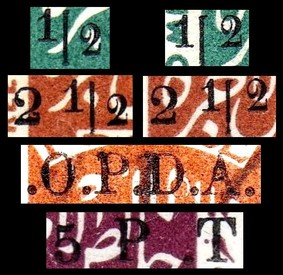
Varieties O81a & O83c (normals on left), O83b, O85a
O81. ½m on 2m green
a. Raised 2 in ½
O82. 1m on 1m brown
O83. 2½m on 3m chestnut
a. Surcharge inverted
b. Extra stop before O.P.D.A.
c. Raised 2 in ½
O84. 1p on 1p indigo (surch in gold)
O85. 5p on 5p purple
a. Wide space between P and full stop in P.T.
Note: Bale distinguishes clean from rough perforations on the 1m, 2½m and 5p values.
a. Raised 2 in ½
O82. 1m on 1m brown
O83. 2½m on 3m chestnut
a. Surcharge inverted
b. Extra stop before O.P.D.A.
c. Raised 2 in ½
O84. 1p on 1p indigo (surch in gold)
O85. 5p on 5p purple
a. Wide space between P and full stop in P.T.
Note: Bale distinguishes clean from rough perforations on the 1m, 2½m and 5p values.
b) Overprinted in sans-serif font, lines of overprint 4 mm apart, value shown as Pt. on 1p value, otherwise as Mill or P.T.
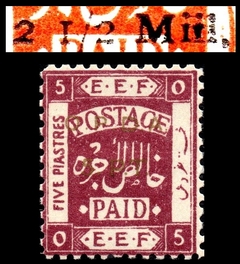
Surch variety O94a (top) and 5p p11½ forgery (below)
O91. ½m on 4m red
O93. 1m on 1m brown (surch in gold)
O94. 2½m on 3m chestnut
a. Variety Miil instead of Mill
O95. 5m on 5m orange
O96. 1p on 1p indigo (surch in red)
O97. 1p on 1p indigo (surch in gold)
O98. 2p on 2p olive
O99. 5p on 5p purple (surch in black)
O100. 5p on 5p purple (surch in gold)
O101. 10p on 10p ultramarine
O102. 20p on 20p grey
Notes:
1. Both Bale and Wallerstein list the 1m surcharged in black and the 20p surcharged in gold, with Wallerstein also listing the 2p surcharged in gold. I have not seen these, though it might be significant that the gold ink degrades over time and can appear black.
2. Bale lists the ½m with small letters of overprint and the 5m with Mili or Miii instead of Mill. Wallerstein lists the 2½m with O.P.D.A. below the figures of surcharge. I have not seen any of these varieties.
3. Bale notes that the ½m, 2½m, 1p (surch in gold), 2p and 5p can be found with rough perforations.
4. Forgeries exist of the 5p with gold surcharge, as shown above right. They can be easily distinguished from genuine examples, the forgeries being perf 11½ and unwatermarked.
O93. 1m on 1m brown (surch in gold)
O94. 2½m on 3m chestnut
a. Variety Miil instead of Mill
O95. 5m on 5m orange
O96. 1p on 1p indigo (surch in red)
O97. 1p on 1p indigo (surch in gold)
O98. 2p on 2p olive
O99. 5p on 5p purple (surch in black)
O100. 5p on 5p purple (surch in gold)
O101. 10p on 10p ultramarine
O102. 20p on 20p grey
Notes:
1. Both Bale and Wallerstein list the 1m surcharged in black and the 20p surcharged in gold, with Wallerstein also listing the 2p surcharged in gold. I have not seen these, though it might be significant that the gold ink degrades over time and can appear black.
2. Bale lists the ½m with small letters of overprint and the 5m with Mili or Miii instead of Mill. Wallerstein lists the 2½m with O.P.D.A. below the figures of surcharge. I have not seen any of these varieties.
3. Bale notes that the ½m, 2½m, 1p (surch in gold), 2p and 5p can be found with rough perforations.
4. Forgeries exist of the 5p with gold surcharge, as shown above right. They can be easily distinguished from genuine examples, the forgeries being perf 11½ and unwatermarked.
1924 (according to Bale). Type D typeset issue reprinted with watermark changed to Block Cypher (sideways) and each value now in a different colour. Perf 11, imperf sheet edges.

Normal 2 (left) and 'Small 2' variety (right)
O111. ½m olive-yellow
O112. 1m deep violet
O113. 2½m blue
a. Small 2
O114. 5m red
O115. 1p green
O116. 2p yellow
O117. 3p grey-green
O118. 5p violet
O119. 10p brown
Notes:
1. Both Bale and Wallerstein list a 1p red and a 50p black, and Wallerstein and Barefoot additionally list a 1m red and a 50p gold. I have not seen any of these.
2. All the above values are known with both types of sideways watermark, ie with the crown pointing to either the right or the left (as seen from the back of the stamp), with no apparent difference in scarcity between the two types.
3. Bale notes that the 2½m can be found with rough perforations. Barefoot lists perf 9½-10½ and perf 11½ varieties on the 5m, but I have not seen these.
4. Wallerstein lists several minor varieties on the ½m, 2½m, 1p and 5p in which full stops are missing after the letters O, P, D or A in OPDA.
O112. 1m deep violet
O113. 2½m blue
a. Small 2
O114. 5m red
O115. 1p green
O116. 2p yellow
O117. 3p grey-green
O118. 5p violet
O119. 10p brown
Notes:
1. Both Bale and Wallerstein list a 1p red and a 50p black, and Wallerstein and Barefoot additionally list a 1m red and a 50p gold. I have not seen any of these.
2. All the above values are known with both types of sideways watermark, ie with the crown pointing to either the right or the left (as seen from the back of the stamp), with no apparent difference in scarcity between the two types.
3. Bale notes that the 2½m can be found with rough perforations. Barefoot lists perf 9½-10½ and perf 11½ varieties on the 5m, but I have not seen these.
4. Wallerstein lists several minor varieties on the ½m, 2½m, 1p and 5p in which full stops are missing after the letters O, P, D or A in OPDA.
Postal Order poundage
Illustrated above is a postal order issued by the British authorities for use in Palestine. It shows a fee (poundage) of 10 mils payable on the face value of one Palestinian pound. I have seen examples of this order used from 1946 to 1948. Such items are not listed on this website but further information can be obtained from the Postal Order Society.
Revenue
To see how my listing of the EEF provisional issues relates to other published catalogues of Palestine revenues, please see the supplementary information page here.
To see how my listing of the EEF provisional issues relates to other published catalogues of Palestine revenues, please see the supplementary information page here.
c1918. Various types of Turkish revenue adhesives handstamped EEF (19-19½ x 5-6 mm) in violet (where indicated) or shades of blue-black to jet-black. All stamps bear the Ghazi type II tughra (stylised signature) of the Ottoman Emperor Mehmet V except where otherwise noted. Ottoman currency: 40 paras (pa) = 1 piastre (pi).
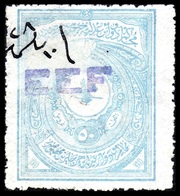
R1
a) Overprinted on Turkish Court Fee stamps
R1. 50pi pale blue (Reshad tughra)
b) Overprinted on Turkish Fixed Fee stamps
R11. 2pa red
R12. 5pa brown (Reshad tughra)
R13. 5pa brown (Ghazi type II tughra)
R14. 10pa lake
R15. 20pa green
a. EEF handstamp in violet
R16. 1pi violet (Ghazi type I tughra)
R17. 1pi deep violet (Ghazi type II tughra)
R18. 2pi claret
R19. 3pi green
R20. 5pi blue-green
R22. 10pi deep brown
R11. 2pa red
R12. 5pa brown (Reshad tughra)
R13. 5pa brown (Ghazi type II tughra)
R14. 10pa lake
R15. 20pa green
a. EEF handstamp in violet
R16. 1pi violet (Ghazi type I tughra)
R17. 1pi deep violet (Ghazi type II tughra)
R18. 2pi claret
R19. 3pi green
R20. 5pi blue-green
R22. 10pi deep brown
c) Overprinted on Turkish Proportional Fee stamps
R30. 10pa claret
R31. 20pa green
R32. 1pi slate-violet
R33. 2pi green
a. EEF handstamp in violet
R36. 10pi green
R37. 25pi greyish violet
R39. 37½pi greyish violet
R30. 10pa claret
R31. 20pa green
R32. 1pi slate-violet
R33. 2pi green
a. EEF handstamp in violet
R36. 10pi green
R37. 25pi greyish violet
R39. 37½pi greyish violet
d) Overprinted on Turkish Receipt stamps
R41. 20pa black on rose (Reshad tughra)
a. Double overprint
R42. 20pa black on rose (Ghazi type II tughra)
a. Opt on stamp previously surcharged ADPO ZO PS1 (Ghazi type II tughra)
R41. 20pa black on rose (Reshad tughra)
a. Double overprint
R42. 20pa black on rose (Ghazi type II tughra)
a. Opt on stamp previously surcharged ADPO ZO PS1 (Ghazi type II tughra)
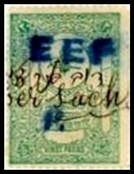 Supposed provisional surcharge (see note 4)
Supposed provisional surcharge (see note 4)
e) Overprinted on Transfer and Purchase of Real Property stamps
R51. 10pa black on blue
R53. 10pi black on rose
Notes:
1. The three different forms of tughra found on these stamps (illustrated above) were all used by the Emperor Mehmed V. The original form reads Mehmed Reshad (his given name); the others read Mehmed Ghazi (Victorious), the name he adopted when Turkey joined the First World War. The Ghazi monogram appears in two different forms.
2. In addition to the above values Bale, Wallerstein and Barefoot list the following values, though they do not specify the appropriations: 10pa green, 1pi black on grey-blue, 1pi red-brown, 5pi dark brown, 7½pi green, 10pi red and 20pi red. I have not seen any of these.
3. The handstamp most commonly found on the above issue measures 19 x 6 mm. R14 has a slightly larger handstamp measuring 19½ x 7 mm, and both types of handstamp can be found on R12 and R15. I am not aware of these handstamps having ever been forged, though it is possible that forgeries exist. I would be very pleased to hear from any reader with specialist knowledge in this field.
4. Illustrated here is a Proportional Fee 20pa stamp similar to my R31 but with a blue handstamp reading EEF, with the letter P on a second line. This was in a major Palestine revenue collection which sold in Kelleher auctions in February 2016, and was written up as a provisional 1 piastre surcharge. In my view the status of this stamp is yet to be established, and I would be glad to receive further information about this stamp.
R51. 10pa black on blue
R53. 10pi black on rose
Notes:
1. The three different forms of tughra found on these stamps (illustrated above) were all used by the Emperor Mehmed V. The original form reads Mehmed Reshad (his given name); the others read Mehmed Ghazi (Victorious), the name he adopted when Turkey joined the First World War. The Ghazi monogram appears in two different forms.
2. In addition to the above values Bale, Wallerstein and Barefoot list the following values, though they do not specify the appropriations: 10pa green, 1pi black on grey-blue, 1pi red-brown, 5pi dark brown, 7½pi green, 10pi red and 20pi red. I have not seen any of these.
3. The handstamp most commonly found on the above issue measures 19 x 6 mm. R14 has a slightly larger handstamp measuring 19½ x 7 mm, and both types of handstamp can be found on R12 and R15. I am not aware of these handstamps having ever been forged, though it is possible that forgeries exist. I would be very pleased to hear from any reader with specialist knowledge in this field.
4. Illustrated here is a Proportional Fee 20pa stamp similar to my R31 but with a blue handstamp reading EEF, with the letter P on a second line. This was in a major Palestine revenue collection which sold in Kelleher auctions in February 2016, and was written up as a provisional 1 piastre surcharge. In my view the status of this stamp is yet to be established, and I would be glad to receive further information about this stamp.
1927. Key type (similar to Palestine Postage Due issue) inscribed Palestine Revenue in English, Hebrew and Arabic. 18 x 22 mm. Perf 14. Watermark Multiple Script CA. Printed (typo) by De La Rue, the 5m to 50m in sheets of 200 (two panes 10x10), the 100m to 500m in sheets of 100.
R101. 5m brown
R102. 10m green
R103. 20m red
R104. 50m violet
a. Bright purple
R105. 100m grey
a. Wmk sideways (1944)
R106. 250m orange
R107. 500m olive
Notes:
1. Each of the above values was reprinted numerous times (see list of recorded printings
on this page). Wartime printings can be identified by the use of rough paper, while post-war printings are on thin smooth chalk-surfaced paper.
2. Shades of all values are known, though the 50m shows the most obvious variation.
3. According to Bale, the 100m with sideways watermark emanates from an April 1944 printing (though Bale misprints this as 1984). The earliest recorded example is dated October 1944, which suggests that this belongs to Requisition 2170/1 (see full list of printings below).
4. Printing details for this and other issues can be found on a dedicated page here.
R101. 5m brown
R102. 10m green
R103. 20m red
R104. 50m violet
a. Bright purple
R105. 100m grey
a. Wmk sideways (1944)
R106. 250m orange
R107. 500m olive
Notes:
1. Each of the above values was reprinted numerous times (see list of recorded printings
on this page). Wartime printings can be identified by the use of rough paper, while post-war printings are on thin smooth chalk-surfaced paper.
2. Shades of all values are known, though the 50m shows the most obvious variation.
3. According to Bale, the 100m with sideways watermark emanates from an April 1944 printing (though Bale misprints this as 1984). The earliest recorded example is dated October 1944, which suggests that this belongs to Requisition 2170/1 (see full list of printings below).
4. Printing details for this and other issues can be found on a dedicated page here.
Revenue usage of Postage stamps
Note: for ease of reference, numbering follows the Stanley Gibbons Part 1 catalogue throughout this section. Values listed here are those recorded as having been used for revenue purposes.
Note: for ease of reference, numbering follows the Stanley Gibbons Part 1 catalogue throughout this section. Values listed here are those recorded as having been used for revenue purposes.
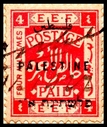
F74
1922. EEF typographed issue inscribed Postage Paid opt PALESTINE in Arabic, English and Hebrew. Perf 14. Wmk Multiple Script CA.
F74. 4m carmine-pink
F74. 4m carmine-pink
1927-45. Pictorials. Perf 13½ x 14½. Wmk Multiple Script CA. Printed (typo) by Harrison.
F90. 2m greenish blue
F91. 3m yellow-green
F93. 5m orange
F95. 7m scarlet
F97b. 10m grey
1932-45. As previous issue but colours changed.
F104. 4m purple
F105. 7m deep violet
F90. 2m greenish blue
F91. 3m yellow-green
F93. 5m orange
F95. 7m scarlet
F97b. 10m grey
1932-45. As previous issue but colours changed.
F104. 4m purple
F105. 7m deep violet
Tobacco and other Excise Banderolles
A banderolle is a kind of revenue stamp printed as a long thin strip which can be wrapped around a taxable commodity such as a box of matches or packet of cigarettes and sealed so that the stamp is destroyed when the pack is opened.
Under the British Mandate of Palestine banderolles were produced for matches, playing cards and six different tobacco products including heisheh and tombac, both of which are largely unknown outside the Middle East. These banderolles do not show the amount of revenue payable but the weight of product on which tax was paid.
The Crown Agents records for Palestine banderolles cover only the period from 1926 to 1940 and in some places are lacking in important details. Most Palestine banderolles are known only from the archives and have not been recorded as issued stamps. They are listed here with catalogue numbers in square brackets.
According to the archive information, all the banderolles listed below were printed by Bradbury Wilkinson on unwatermarked paper in one of three different sheet formats: 26 (one column of 26), 44 (two columns of 22) or 48 (three columns of 16). The paper was unwatermarked and probably ungummed. Most banderolles were issued imperforate except where noted below.
Printing details for all banderolles and other Palestine revenue issues can be found on a dedicated page here.
Under the British Mandate of Palestine banderolles were produced for matches, playing cards and six different tobacco products including heisheh and tombac, both of which are largely unknown outside the Middle East. These banderolles do not show the amount of revenue payable but the weight of product on which tax was paid.
The Crown Agents records for Palestine banderolles cover only the period from 1926 to 1940 and in some places are lacking in important details. Most Palestine banderolles are known only from the archives and have not been recorded as issued stamps. They are listed here with catalogue numbers in square brackets.
According to the archive information, all the banderolles listed below were printed by Bradbury Wilkinson on unwatermarked paper in one of three different sheet formats: 26 (one column of 26), 44 (two columns of 22) or 48 (three columns of 16). The paper was unwatermarked and probably ungummed. Most banderolles were issued imperforate except where noted below.
Printing details for all banderolles and other Palestine revenue issues can be found on a dedicated page here.
1920s-40s. Cigarettes. Inscribed Cigarettes Manufactured in Palestine / Duty Paid. 130 x 19mm. Imperf. Printed in sheets of 44 (2 x 22).
X1. 1g carmine
[X2. 2g red-orange]
[X3. 5g brown]
X4. 6g green
X5. 9g violet
X6. 10g orange-yellow
X7. 16g black
X8. 18g yellow-orange
X9. 20g blue
X10. 21g violet
[X11. 25g orange]
X12. 30g lake
X13. 32g brown
X14. 40g orange
X15. 50g carmine
X1. 1g carmine
[X2. 2g red-orange]
[X3. 5g brown]
X4. 6g green
X5. 9g violet
X6. 10g orange-yellow
X7. 16g black
X8. 18g yellow-orange
X9. 20g blue
X10. 21g violet
[X11. 25g orange]
X12. 30g lake
X13. 32g brown
X14. 40g orange
X15. 50g carmine
The same issue surcharged
X21. 18g on 9g violet
X22. 30g on 5g brown
Notes:
1. The values shown in square brackets have not yet been recorded as issued stamps.
2. The Crown Agents archive contains imperforate proofs of the 1g, 2g, 5g, 9g, 16g, 18g, 20g, 25g, plus perforated proofs of the 1g, 2g and 5g (all from Req 2296), the 6g (Req 2830) and the 10g (Req 1874). However all recorded issued examples of X1/22 are imperforate, and it is possible that the stamps were only issued imperf.
3. There is no reference in the Req Books or the archive to X10 and X12/22. The latest Palestine banderolles entry is dated 1940 so presumably these stamps were issued later than this.
4. Printing details for this and other issues can be found on a dedicated page here.
X21. 18g on 9g violet
X22. 30g on 5g brown
Notes:
1. The values shown in square brackets have not yet been recorded as issued stamps.
2. The Crown Agents archive contains imperforate proofs of the 1g, 2g, 5g, 9g, 16g, 18g, 20g, 25g, plus perforated proofs of the 1g, 2g and 5g (all from Req 2296), the 6g (Req 2830) and the 10g (Req 1874). However all recorded issued examples of X1/22 are imperforate, and it is possible that the stamps were only issued imperf.
3. There is no reference in the Req Books or the archive to X10 and X12/22. The latest Palestine banderolles entry is dated 1940 so presumably these stamps were issued later than this.
4. Printing details for this and other issues can be found on a dedicated page here.
1920s-40s. Cigars. Inscribed Cigars Manufactured in Palestine / Duty Paid. Imperf. Printed in sheets of 44 (2 x 22).
[X31. 1g green]
[X32. 2g red-orange]
[X33. 10g blue]
X34. 25g carmine
[X35. 30g black]
X36. 125g brown
[X37. 145g orange-red]
[X38. 170g blue]
Notes:
1. The values shown in square brackets have not yet been recorded as issued stamps.
2. Printing details for this and other issues can be found on a dedicated page here.
[X31. 1g green]
[X32. 2g red-orange]
[X33. 10g blue]
X34. 25g carmine
[X35. 30g black]
X36. 125g brown
[X37. 145g orange-red]
[X38. 170g blue]
Notes:
1. The values shown in square brackets have not yet been recorded as issued stamps.
2. Printing details for this and other issues can be found on a dedicated page here.
1934. Heisheh. Inscribed Heisheh Manufactured in Palestine / Duty Paid. Printed in sheets of 44 (2 x 22).
[X41. 20g magenta]
Notes:
1. No issued examples are recorded. The proof is imperforate and it is not known whether or not the issued stamps were perforated.
2. Printing details for this and other issues can be found on a dedicated page here.
[X41. 20g magenta]
Notes:
1. No issued examples are recorded. The proof is imperforate and it is not known whether or not the issued stamps were perforated.
2. Printing details for this and other issues can be found on a dedicated page here.
1920s-40s. Matches. Two different formats.
a) No border around design, printed in sheets of 26 (1 x 26)
[X51. [Matches Manufactured in Palestine Excise Duty Paid] yellow]
[X52. [Foreign Manufactured Matches Import Duty Paid] green]
b) Decorative border, printed in sheets of 44 (2 x 22)
[X53. [Foreign Manufactured Matches Import Duty Paid] green]
Notes:
1. No issued examples are recorded. The proofs are imperforate and it is not known whether or not the issued stamps were perforated.
2. Printing details for this and other issues can be found on a dedicated page here.
a) No border around design, printed in sheets of 26 (1 x 26)
[X51. [Matches Manufactured in Palestine Excise Duty Paid] yellow]
[X52. [Foreign Manufactured Matches Import Duty Paid] green]
b) Decorative border, printed in sheets of 44 (2 x 22)
[X53. [Foreign Manufactured Matches Import Duty Paid] green]
Notes:
1. No issued examples are recorded. The proofs are imperforate and it is not known whether or not the issued stamps were perforated.
2. Printing details for this and other issues can be found on a dedicated page here.
1926. Playing Cards. Inscribed Foreign Manufactured Playing Cards / Import Duty Paid. Printed in sheets of 26 (1 x 26).
[X61. [Foreign Manufactured - Import Duty Paid] orange-red]
Notes:
1. No issued examples are recorded. The proof is perforated so I presume that the stamps were issued in this state.
2. Printing details for this and other issues can be found on a dedicated page here.
[X61. [Foreign Manufactured - Import Duty Paid] orange-red]
Notes:
1. No issued examples are recorded. The proof is perforated so I presume that the stamps were issued in this state.
2. Printing details for this and other issues can be found on a dedicated page here.
1926. Snuff. Inscribed Snuff Manufactured in Palestine / Duty Paid. Printed in sheets of 48 (3 x 16).
[X71. 10g light blue]
[X72. 30g ?colour]
Notes:
1. No issued examples are recorded. The proof is imperforate and it is not known whether or not the issued stamps were perforated. No proof for X72 is in the archive but its existence is known from the Requisition books.
2. Printing details for this and other issues can be found on a dedicated page here.
[X71. 10g light blue]
[X72. 30g ?colour]
Notes:
1. No issued examples are recorded. The proof is imperforate and it is not known whether or not the issued stamps were perforated. No proof for X72 is in the archive but its existence is known from the Requisition books.
2. Printing details for this and other issues can be found on a dedicated page here.
1926-40. Tobacco. Separate issues for tobacco manufactured in Palestine and abroad. Three different sheet formats: X81 - 44 (2 x 22), X82/83 - 26 (1 x 26), X86/87 - 48 (3 x 16).
a) Inscribed Palestine Tobacco Duty Paid
[X81. 10g red]
X82. 20g black (1929)
[X83. 100g red (1932)]
b) Inscribed Foreign Manufactured Tobacco
[X86. [Import Duty Free] black]
X87. [Import Duty Paid] red
Notes:
1. Issued examples of X87 are known both perforated and imperf. X82 is known imperf only. The archive proofs are perforated (X81 and X86/87) or imperf (X82/83). No issued examples of X81, X83 or X86 are known.
2. Printing details for this and other issues can be found on a dedicated page here.
a) Inscribed Palestine Tobacco Duty Paid
[X81. 10g red]
X82. 20g black (1929)
[X83. 100g red (1932)]
b) Inscribed Foreign Manufactured Tobacco
[X86. [Import Duty Free] black]
X87. [Import Duty Paid] red
Notes:
1. Issued examples of X87 are known both perforated and imperf. X82 is known imperf only. The archive proofs are perforated (X81 and X86/87) or imperf (X82/83). No issued examples of X81, X83 or X86 are known.
2. Printing details for this and other issues can be found on a dedicated page here.
1926-38. Tombac. Inscribed Tombac Duty Paid. Printed in sheets of 26 (1 x 26)
[X91. 20g grey (1927)]
[X92. 25g claret (1929)]
[X93. 30g blue-green]
[X94. 60g grey-lilac (1934)]
Notes:
1. No issued examples are recorded. The proofs are imperforate and it is not known whether or not the issued stamps were perforated.
2. Printing details for this and other issues can be found on a dedicated page here.
[X91. 20g grey (1927)]
[X92. 25g claret (1929)]
[X93. 30g blue-green]
[X94. 60g grey-lilac (1934)]
Notes:
1. No issued examples are recorded. The proofs are imperforate and it is not known whether or not the issued stamps were perforated.
2. Printing details for this and other issues can be found on a dedicated page here.
Details of Palestine revenue printings can be found here
A cross-reference table for Palestine revenue catalogues can be found here


















